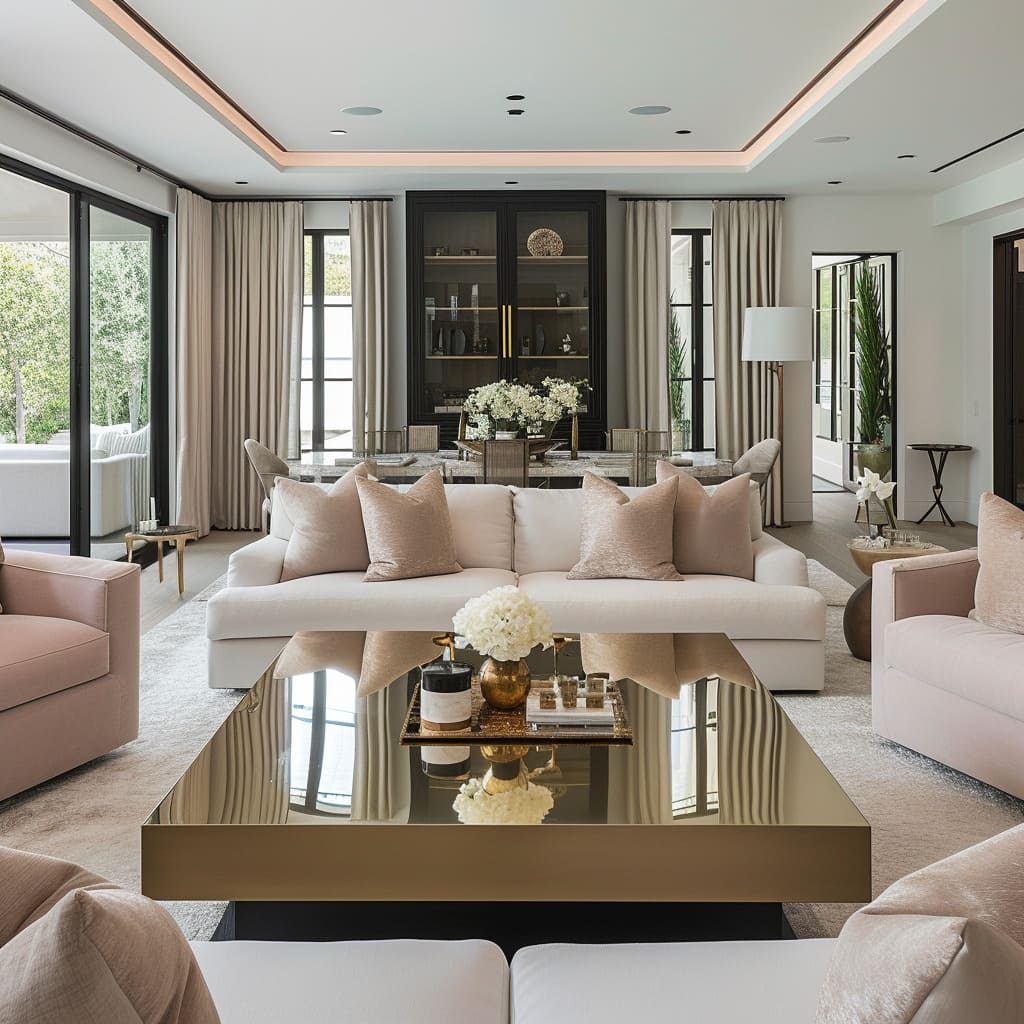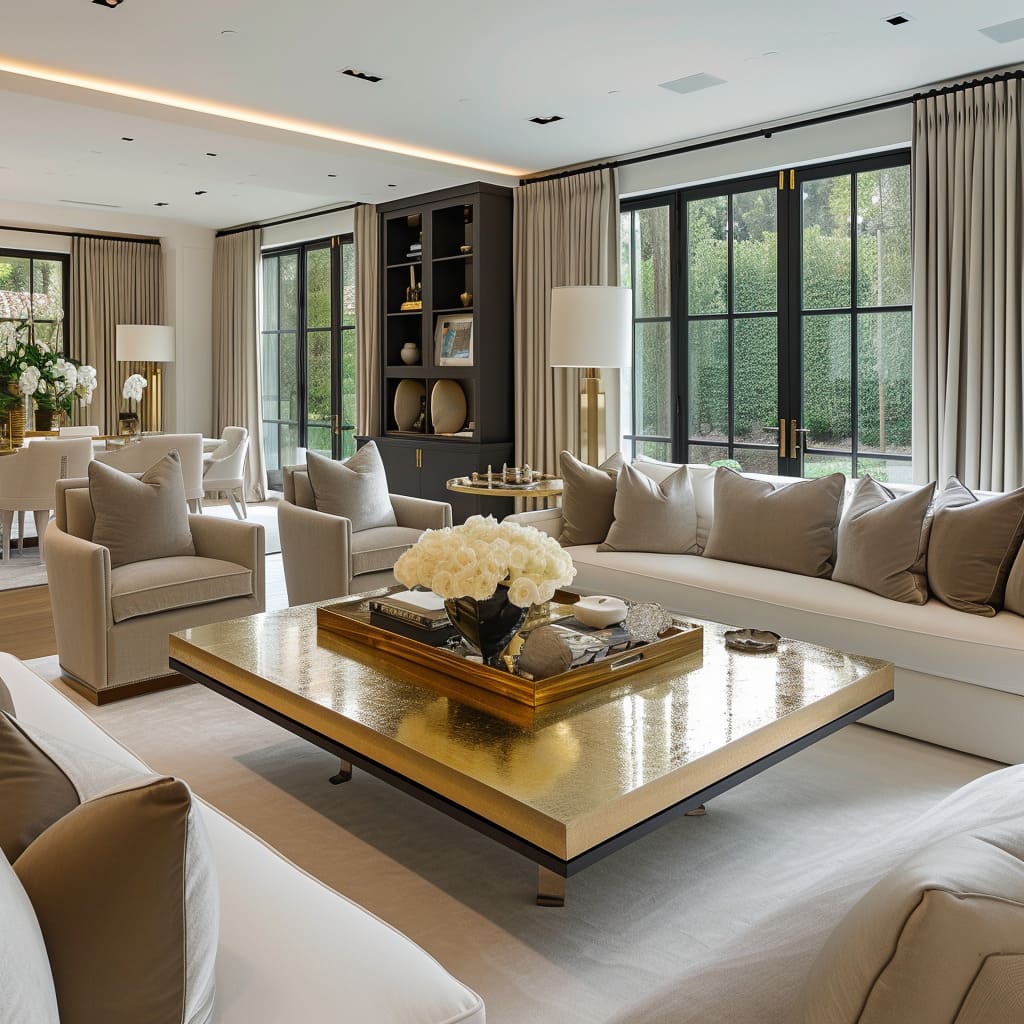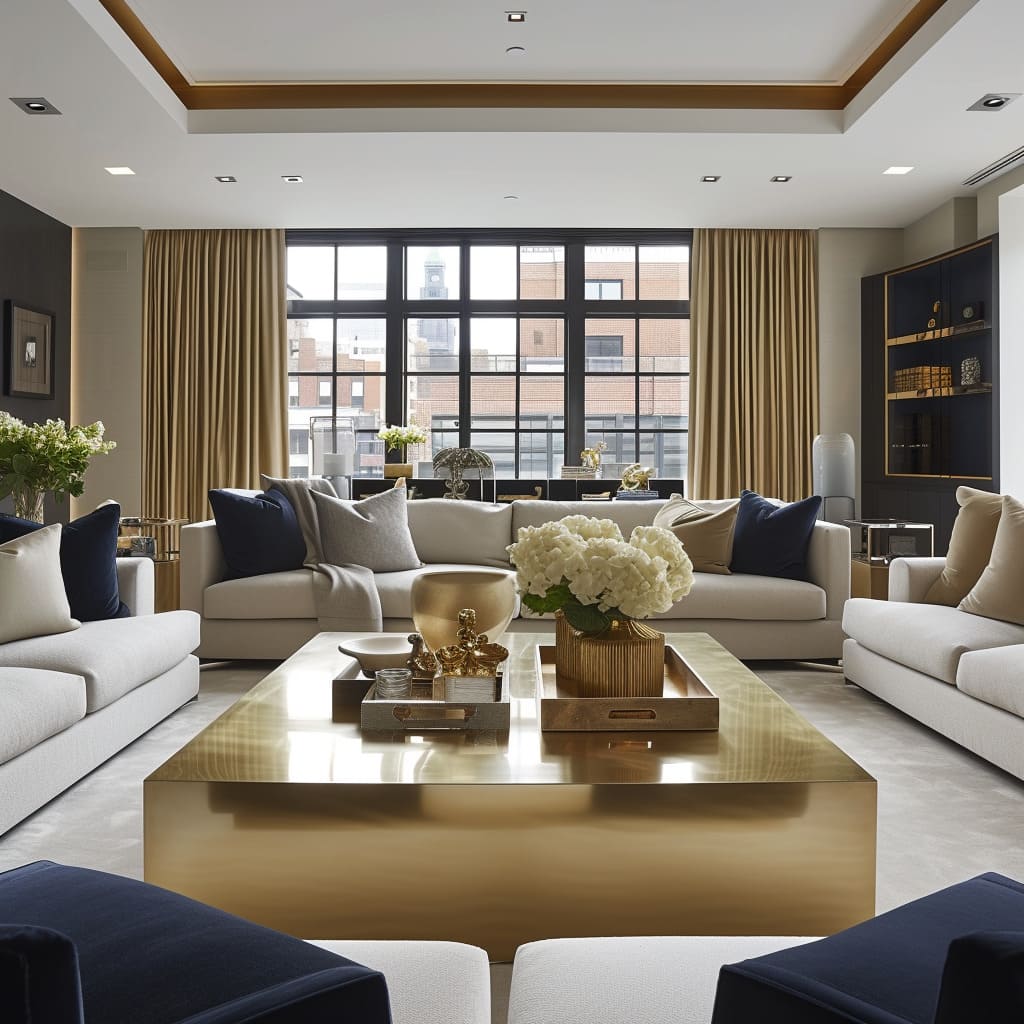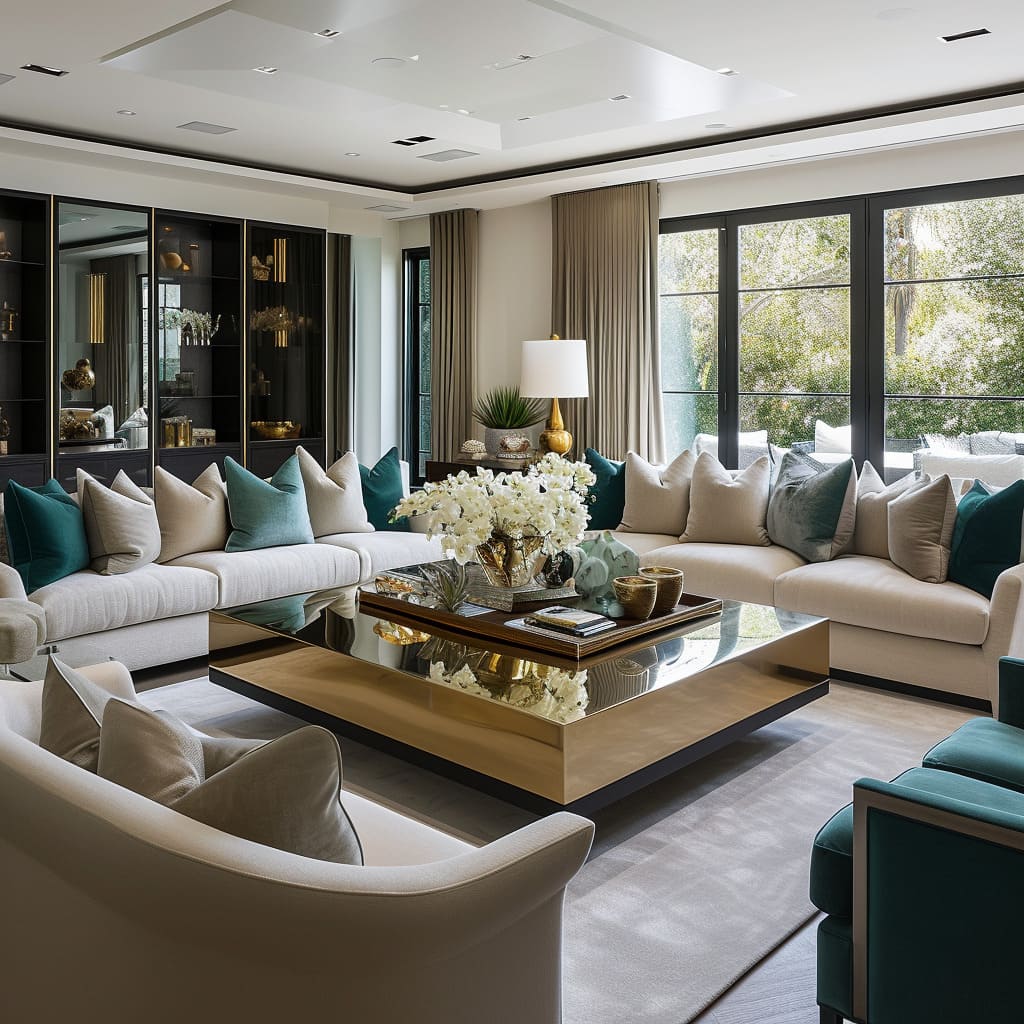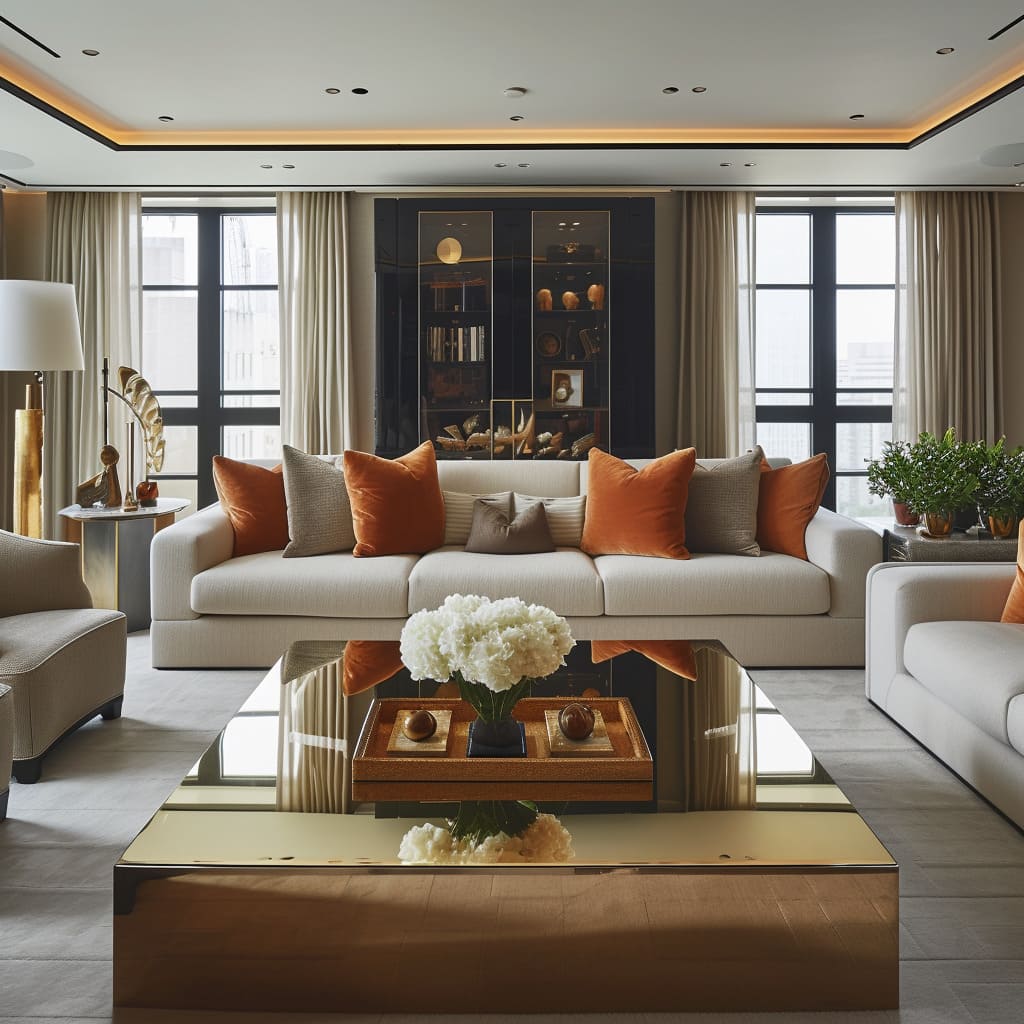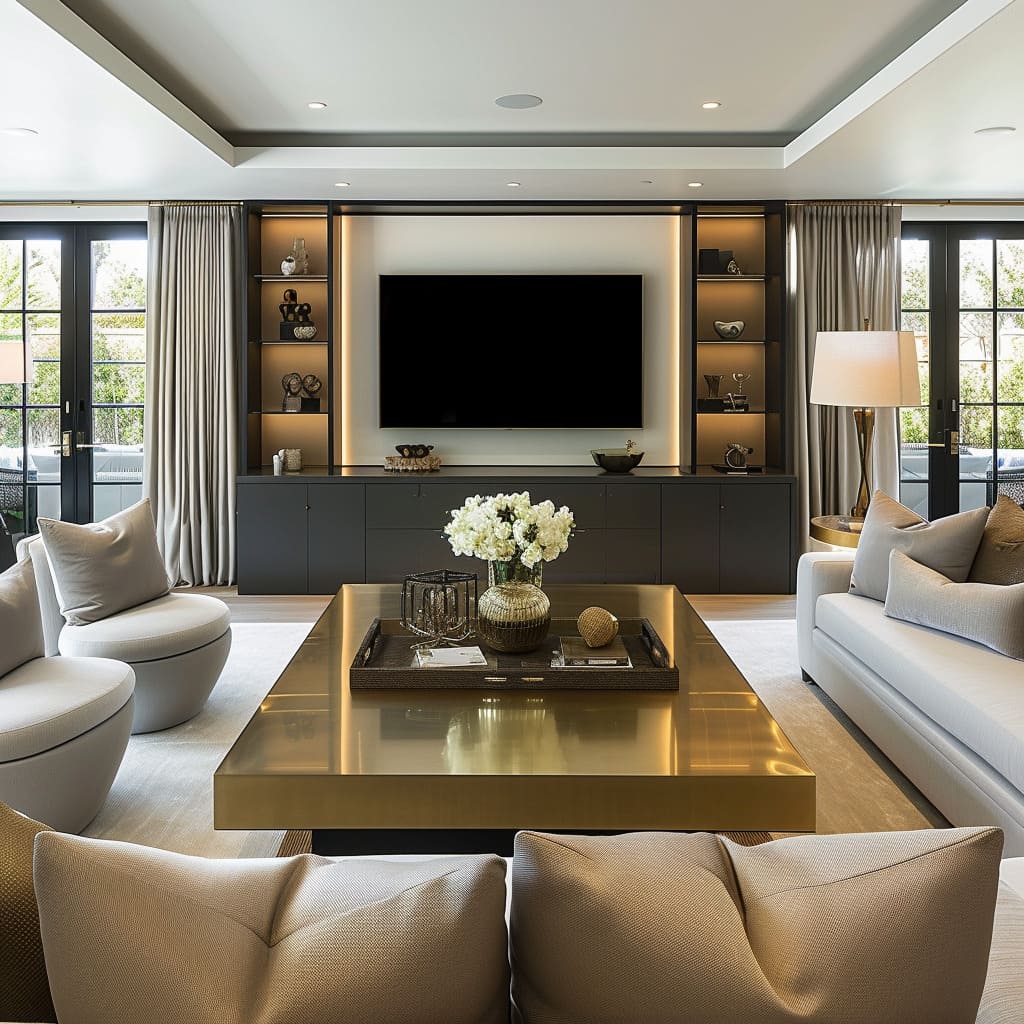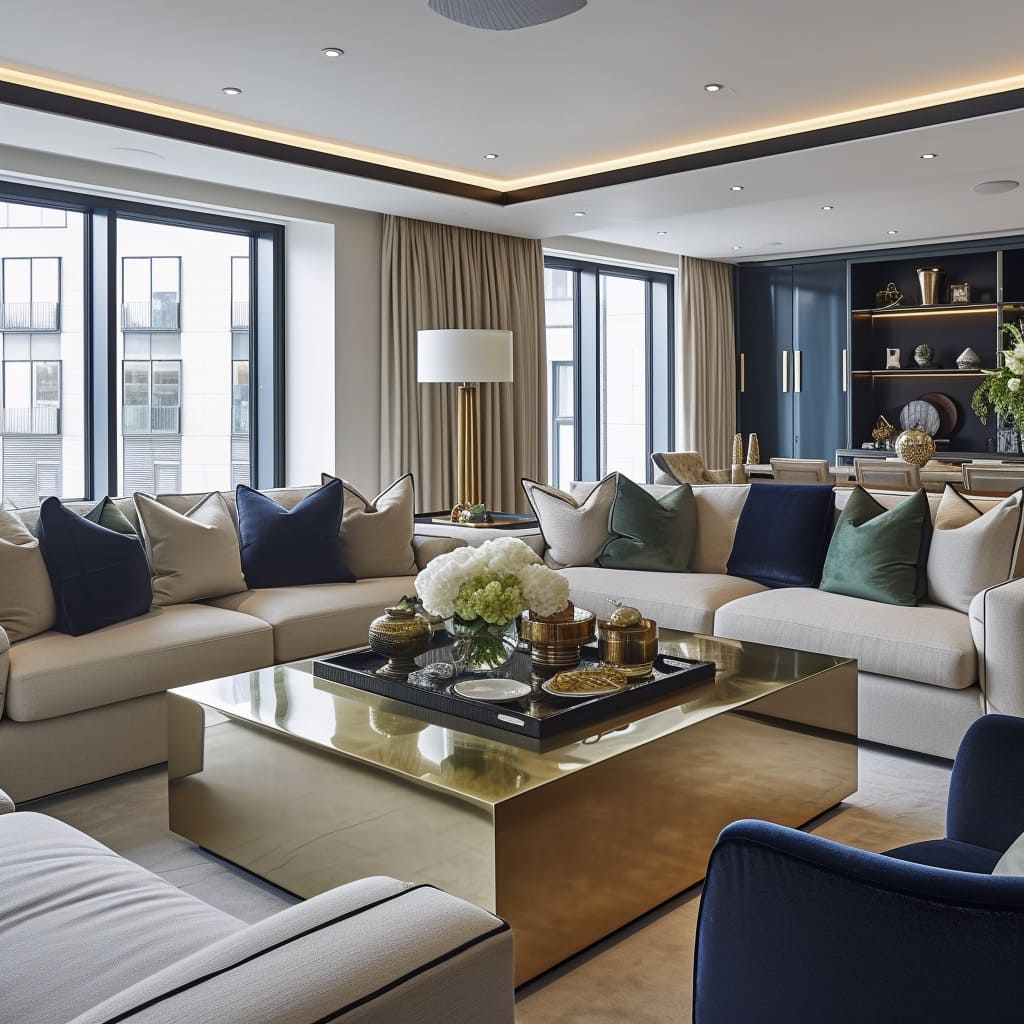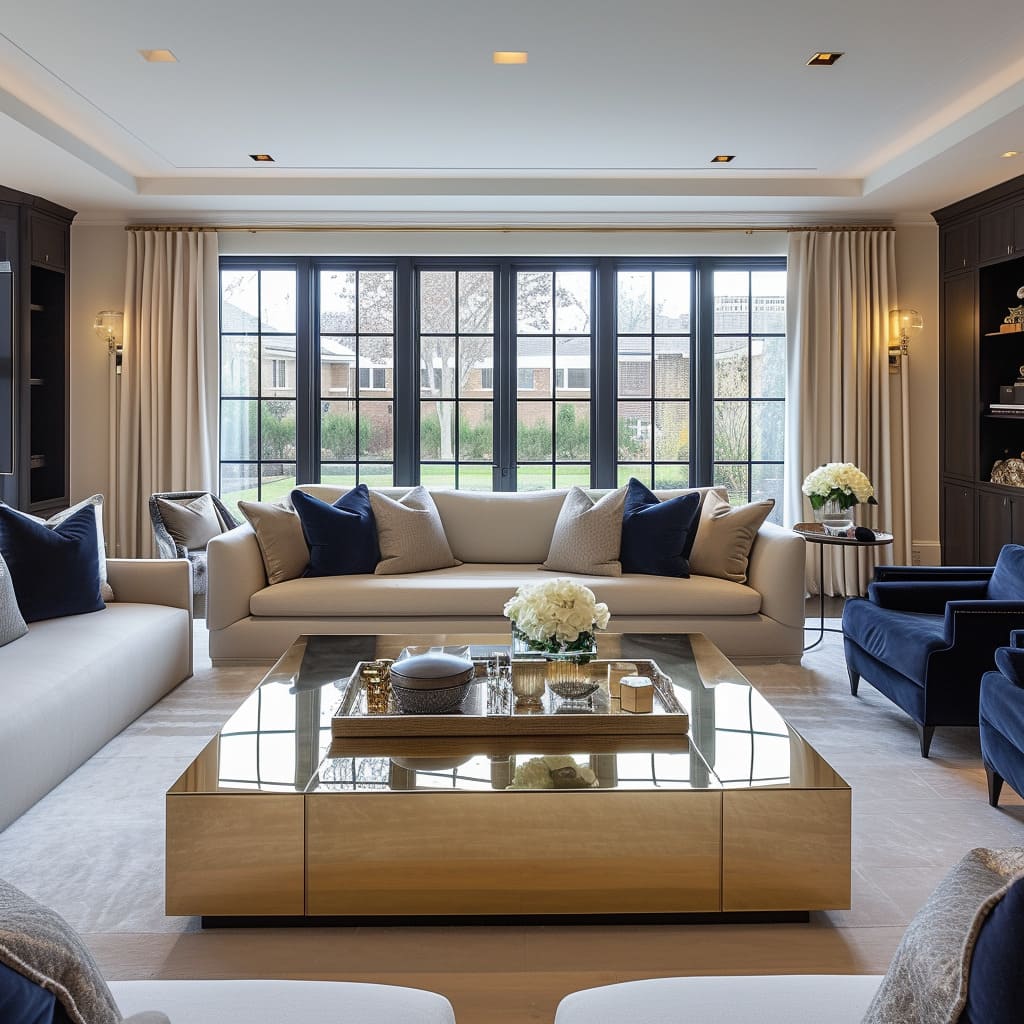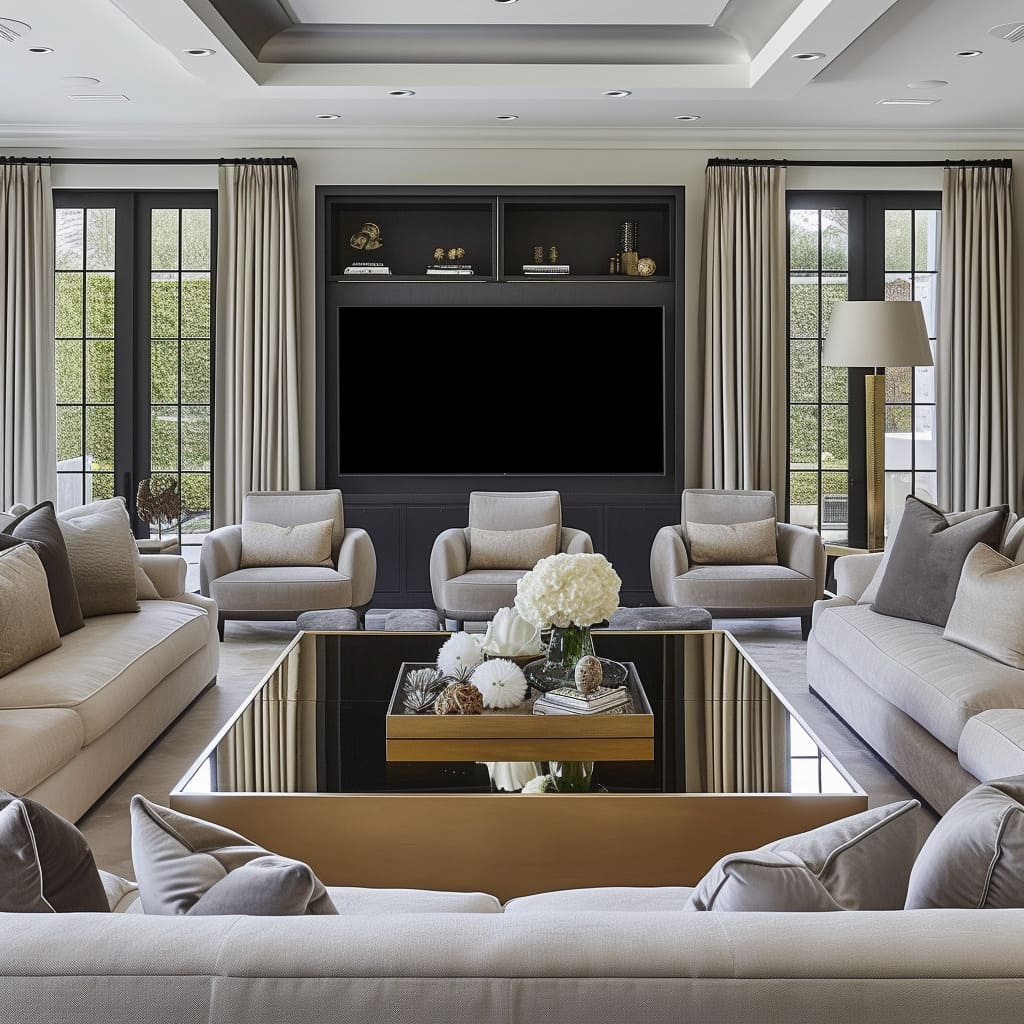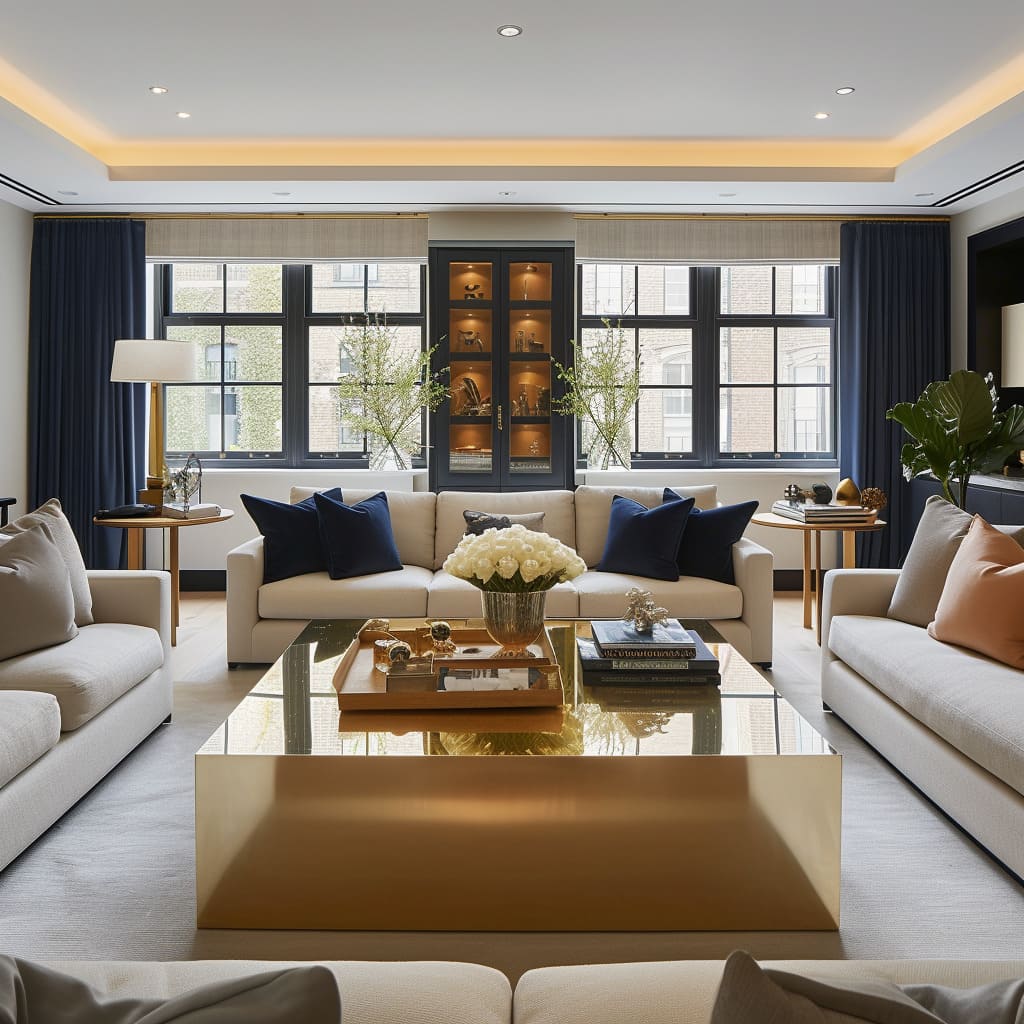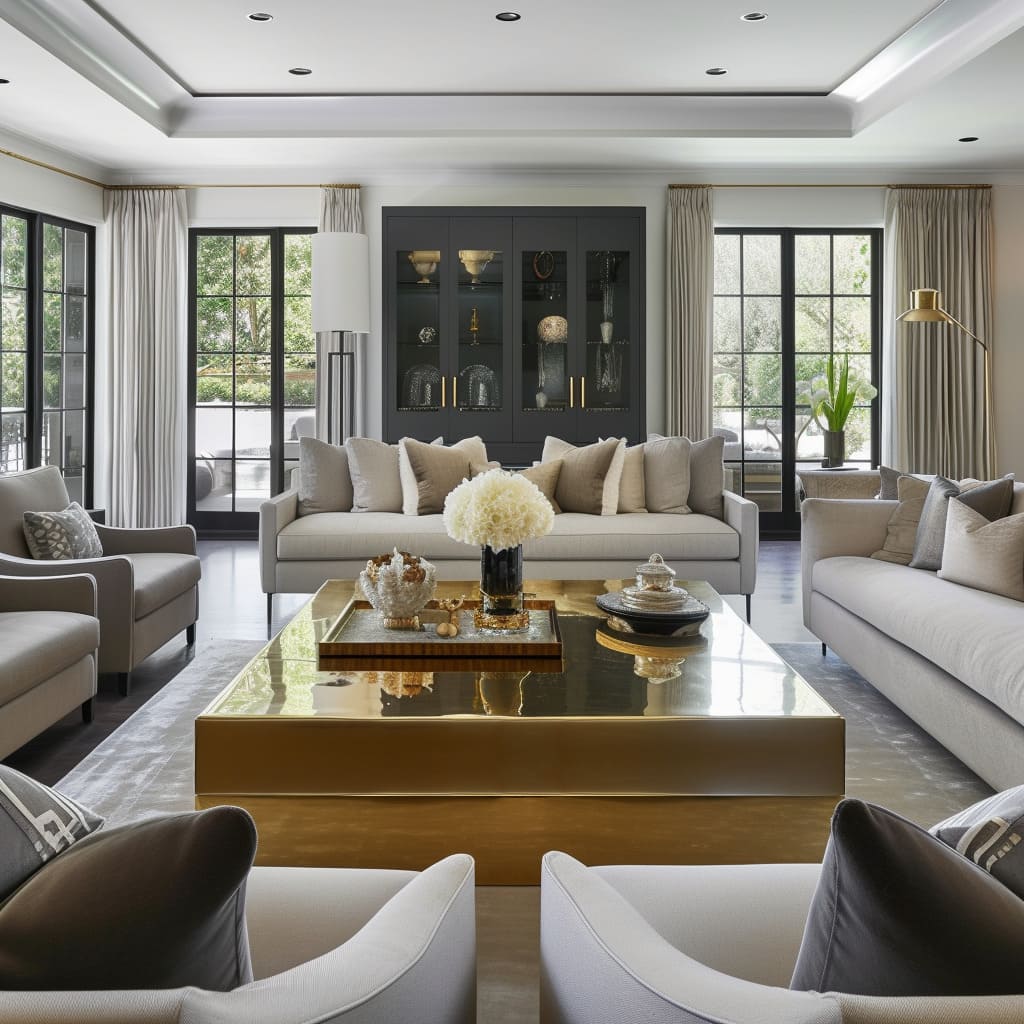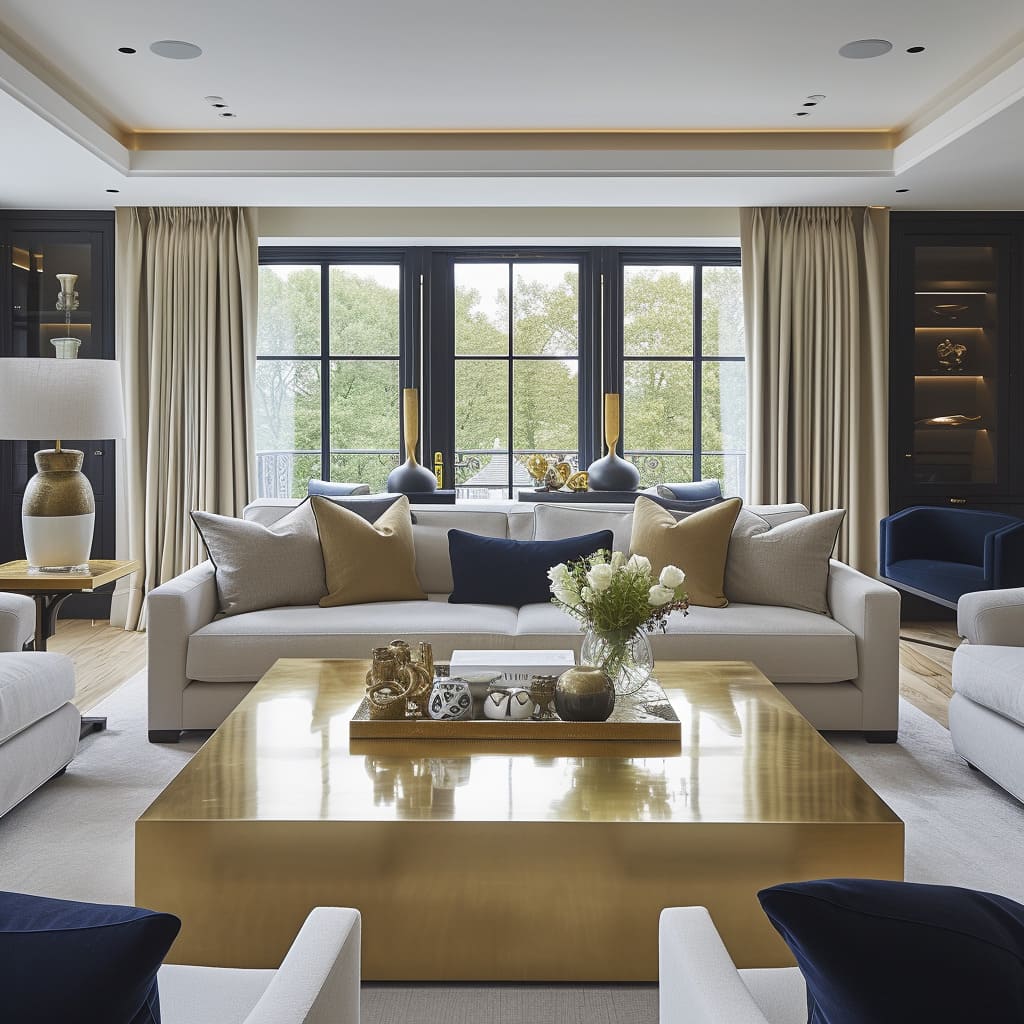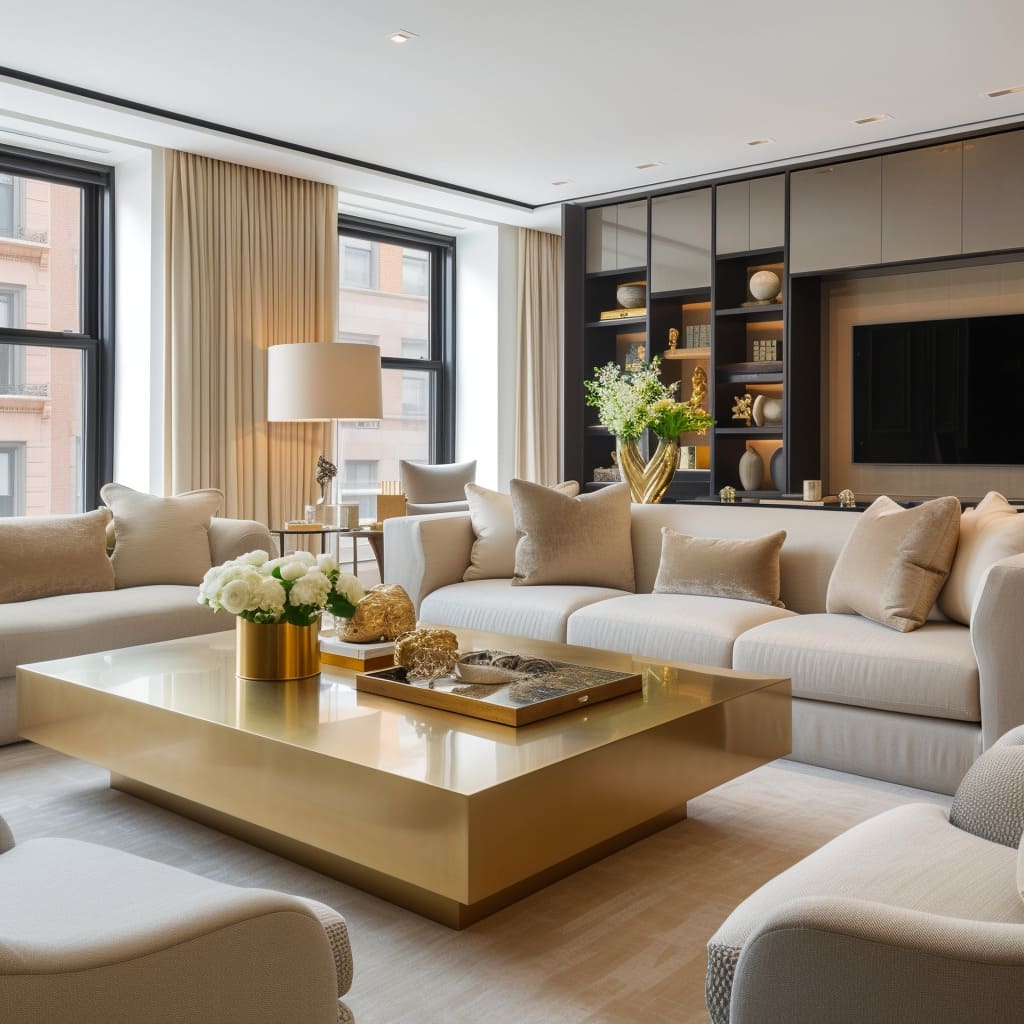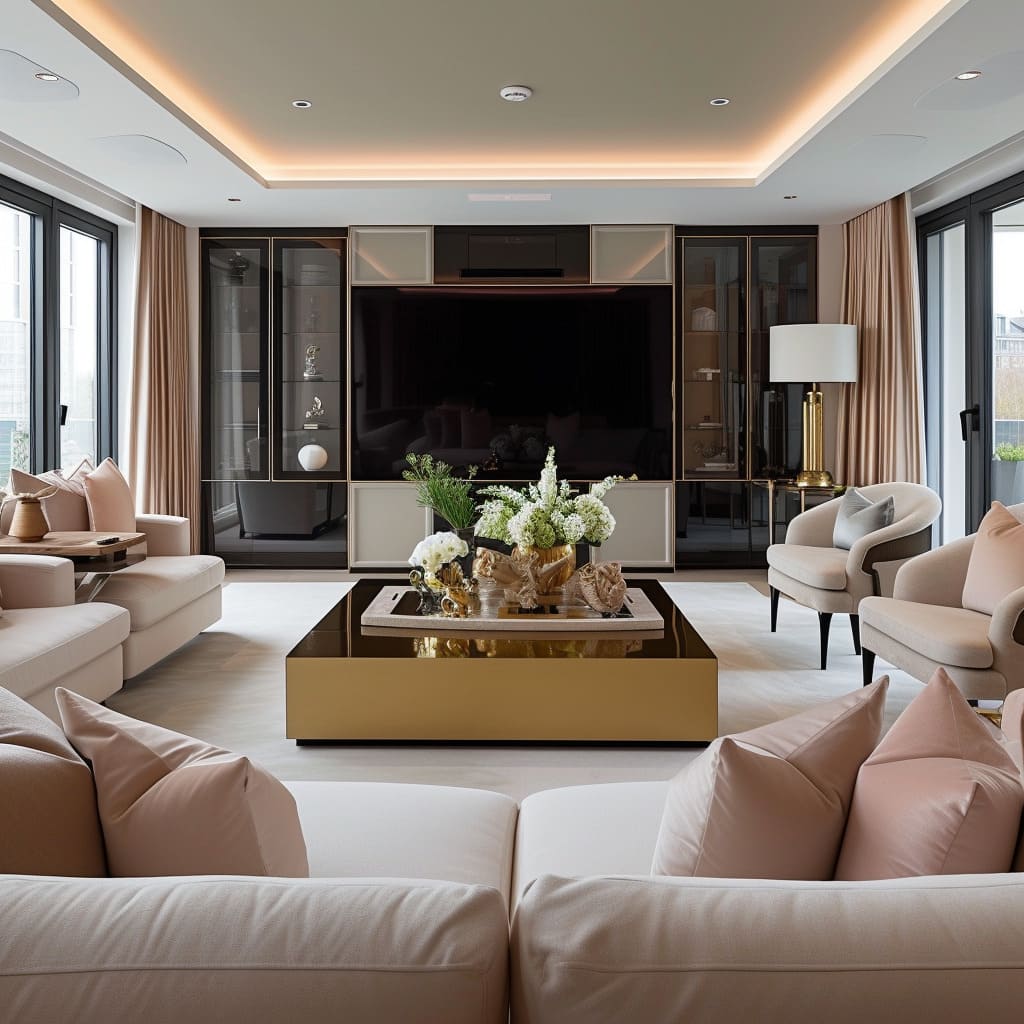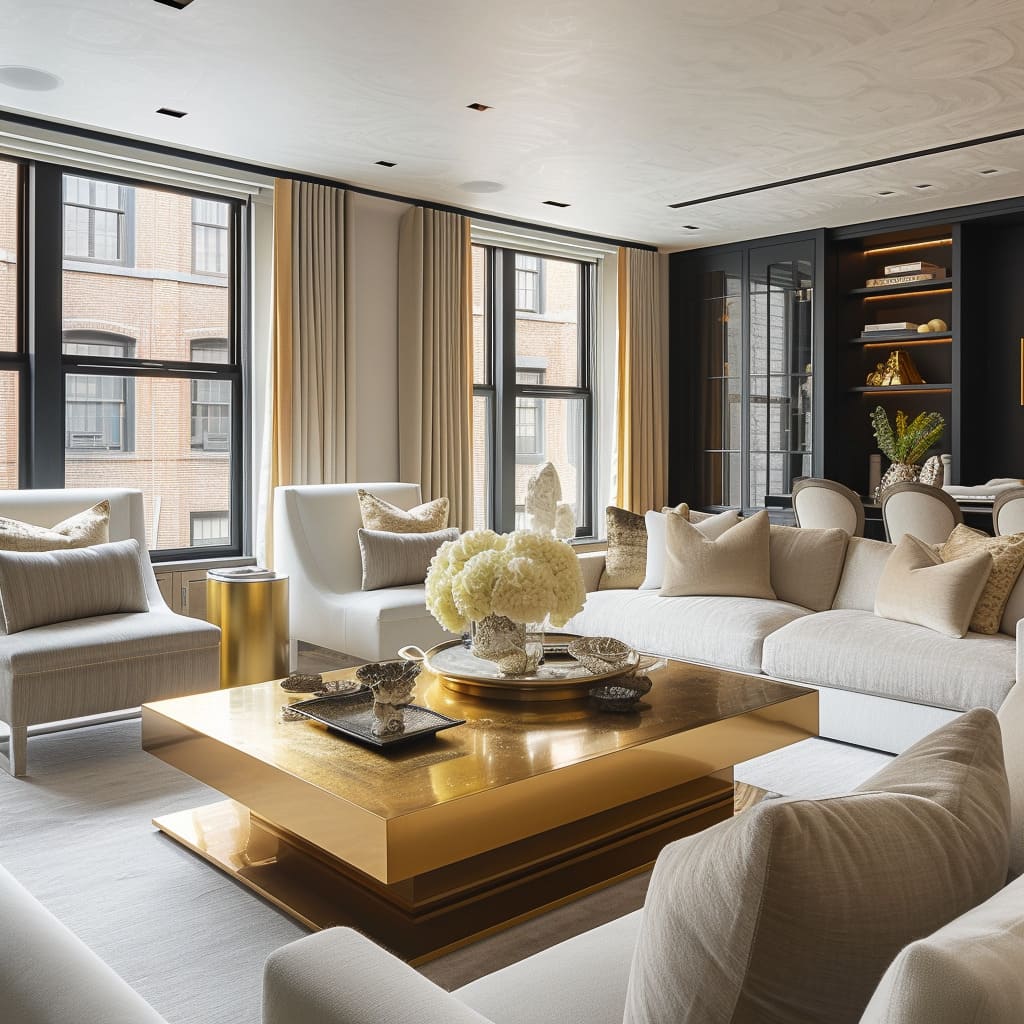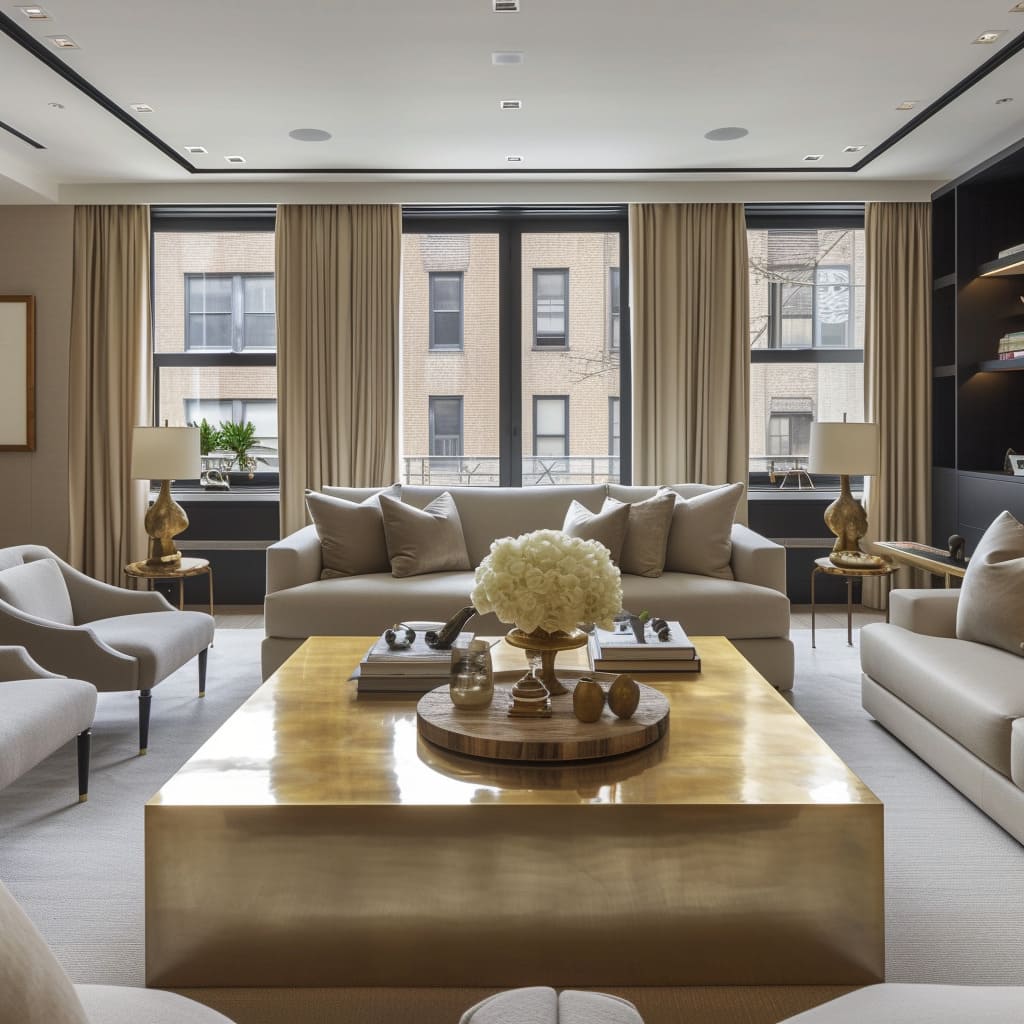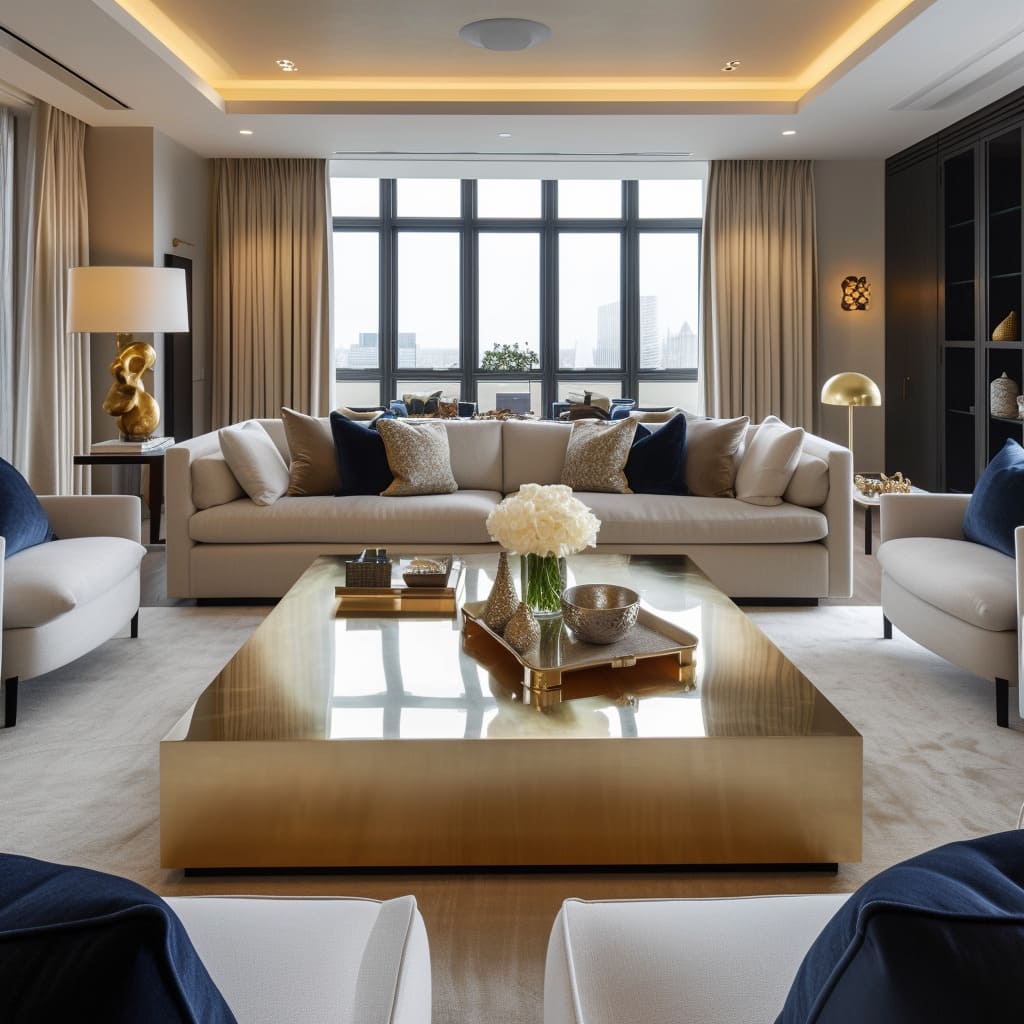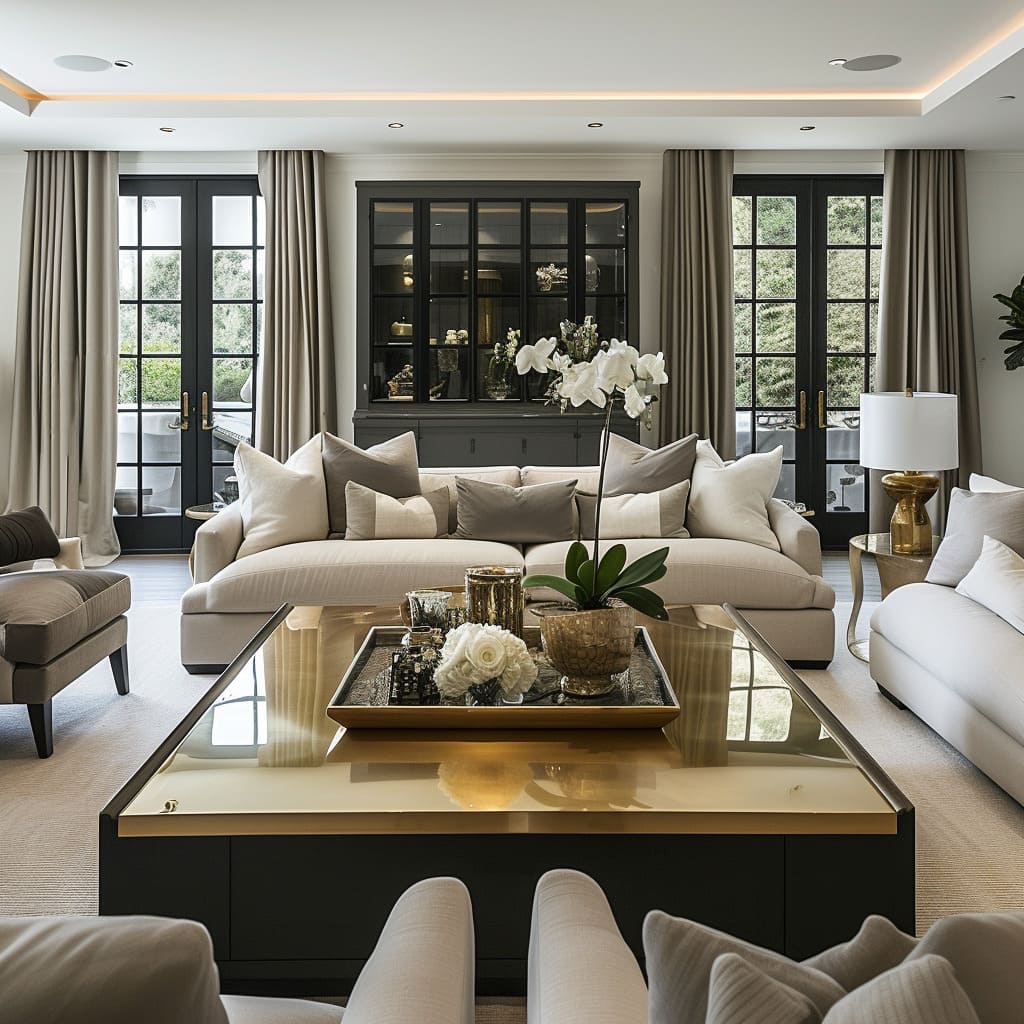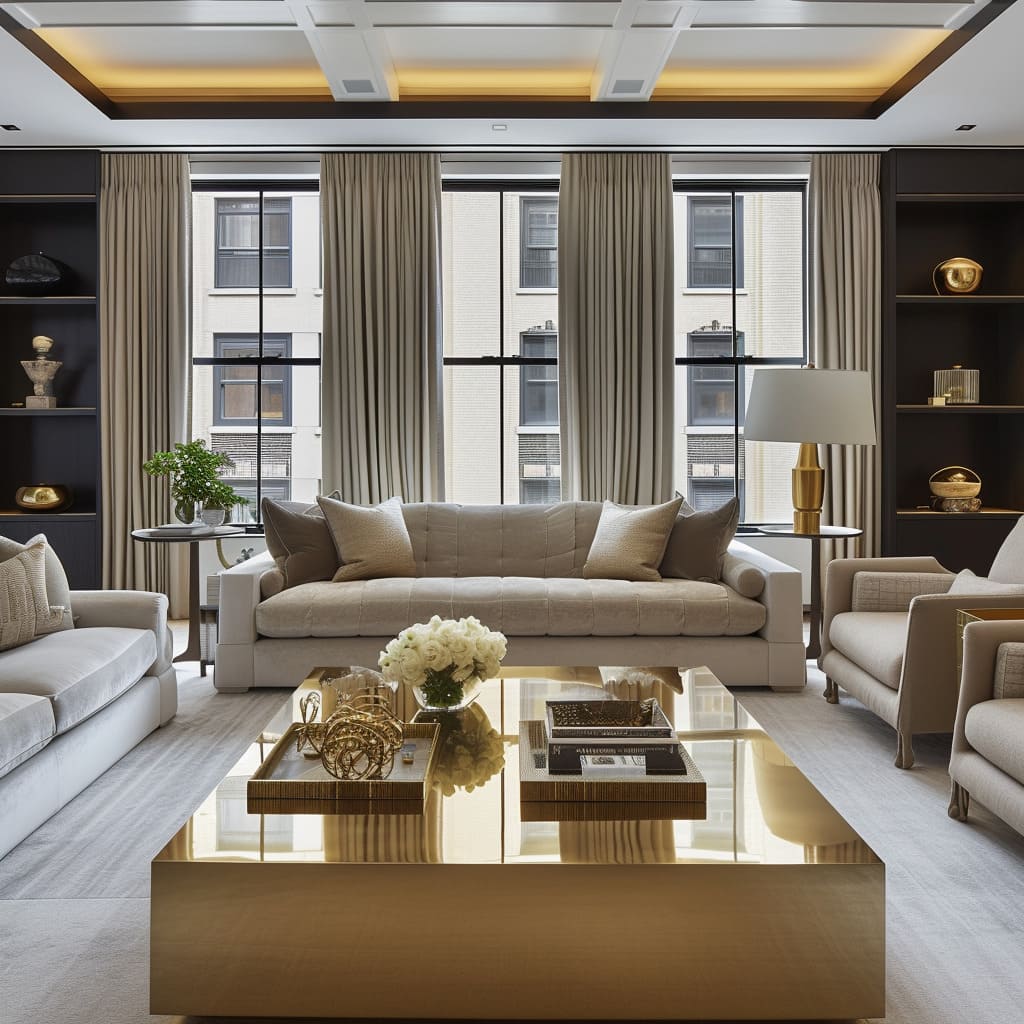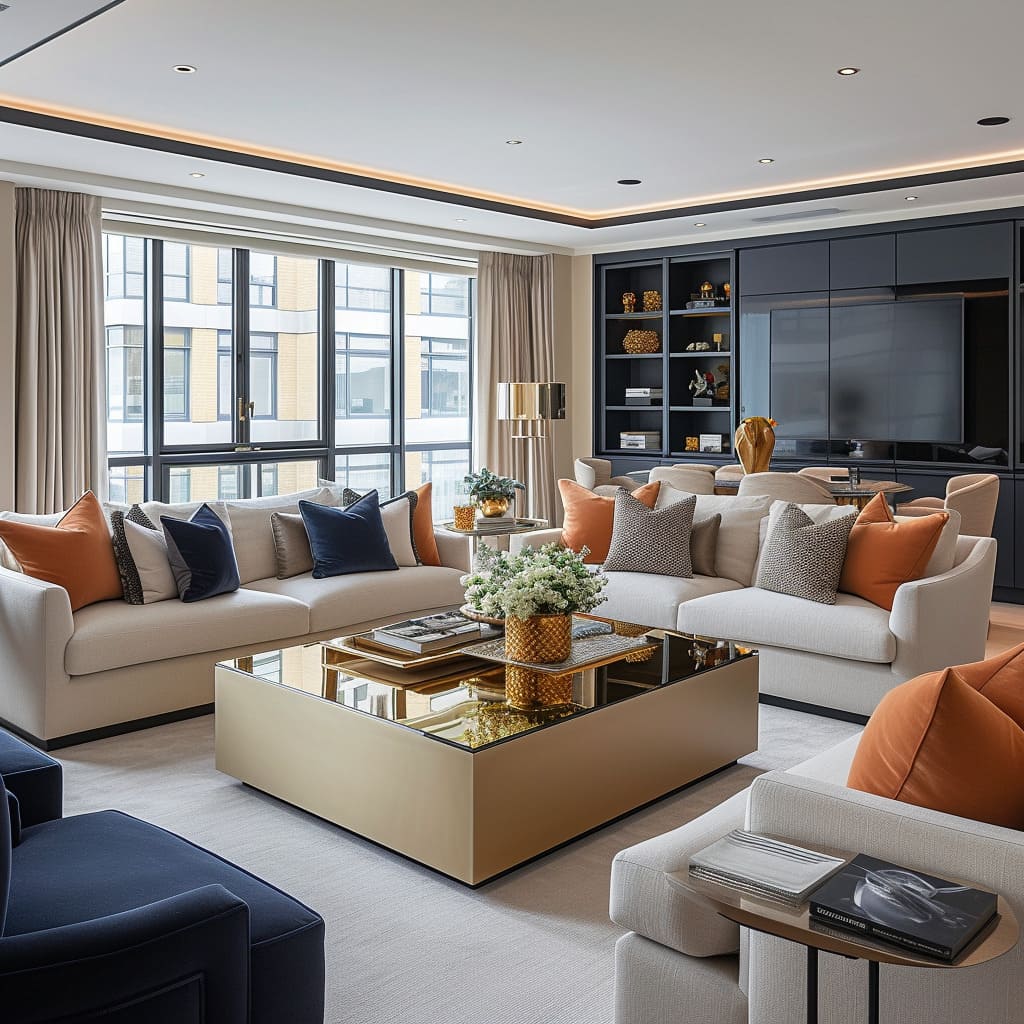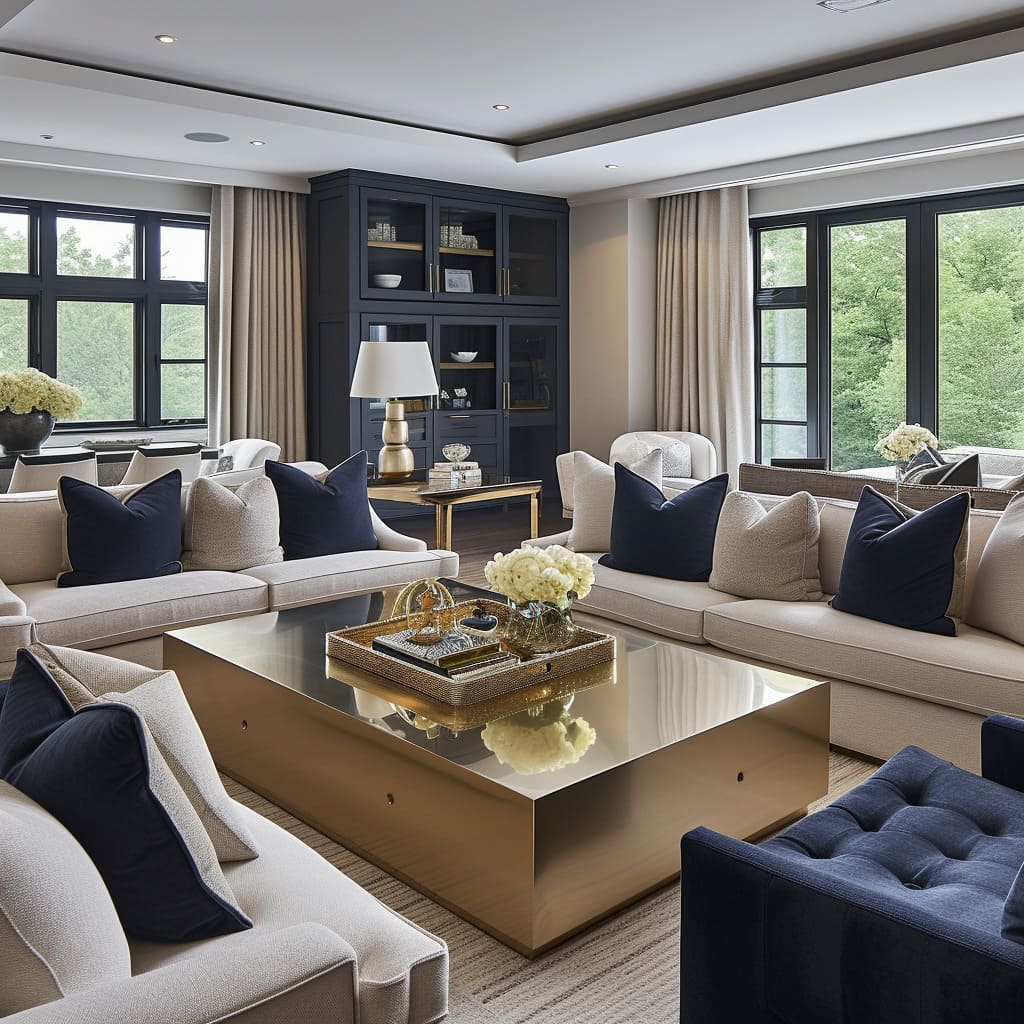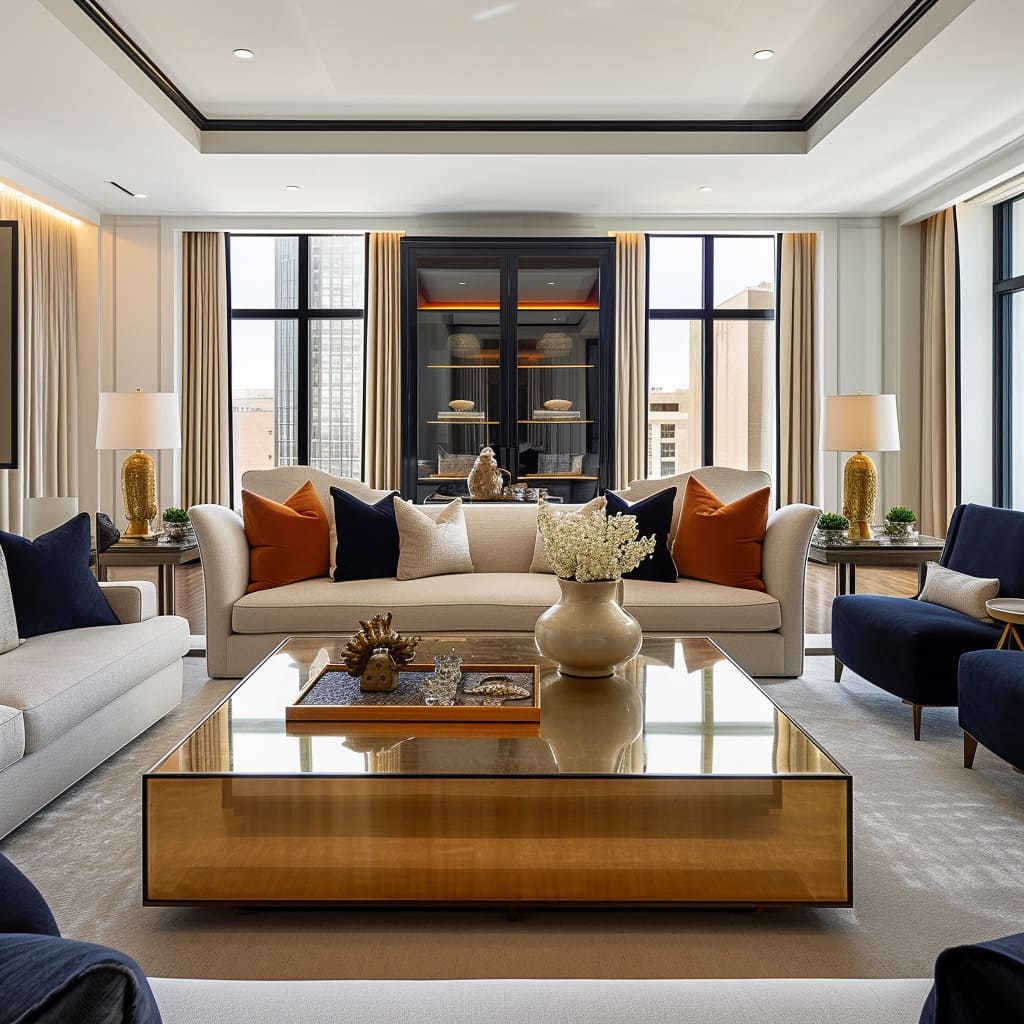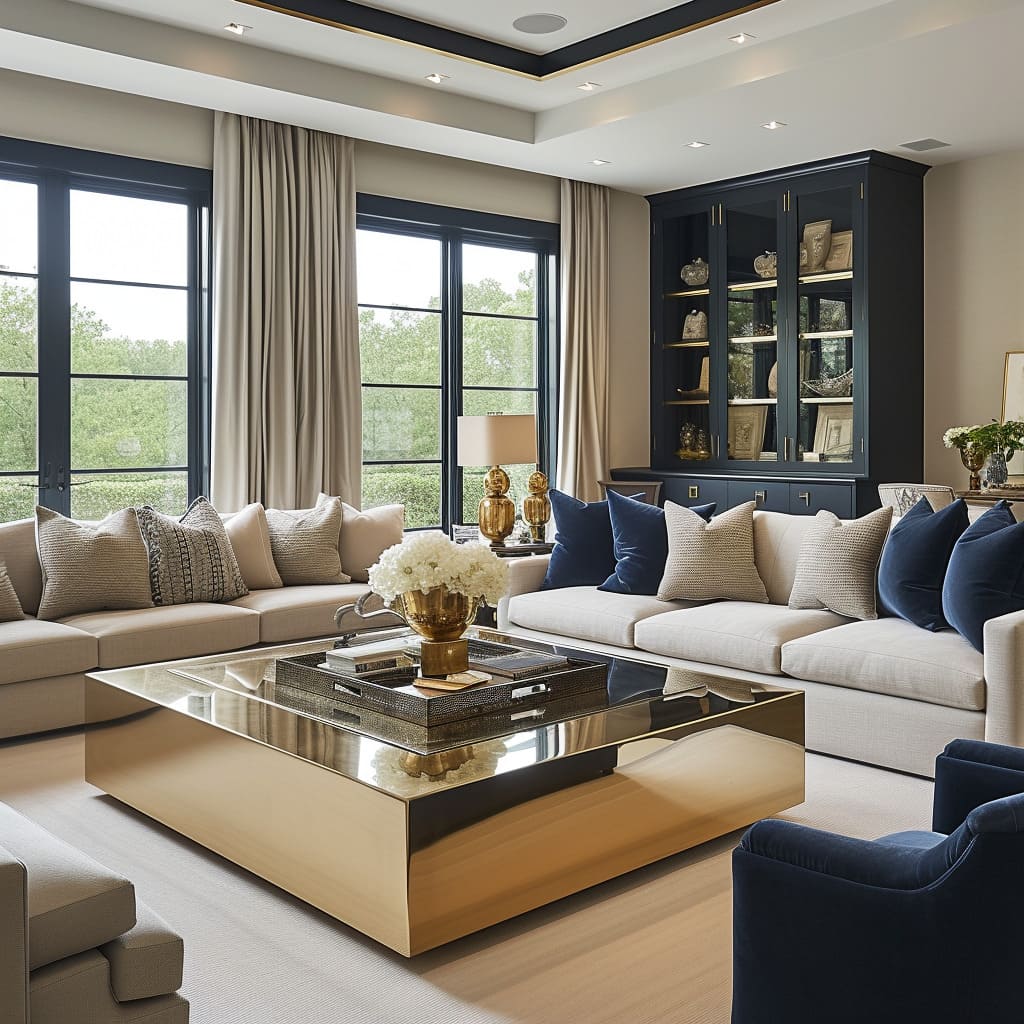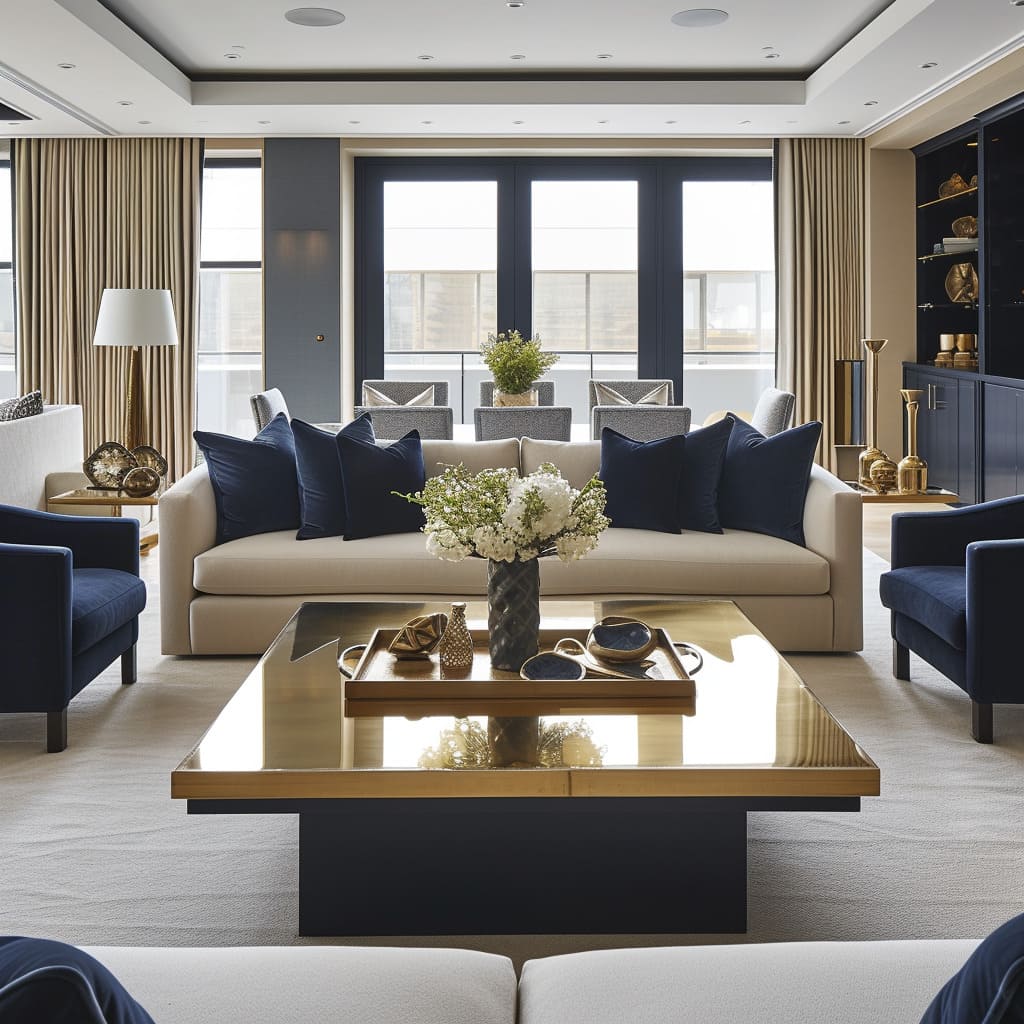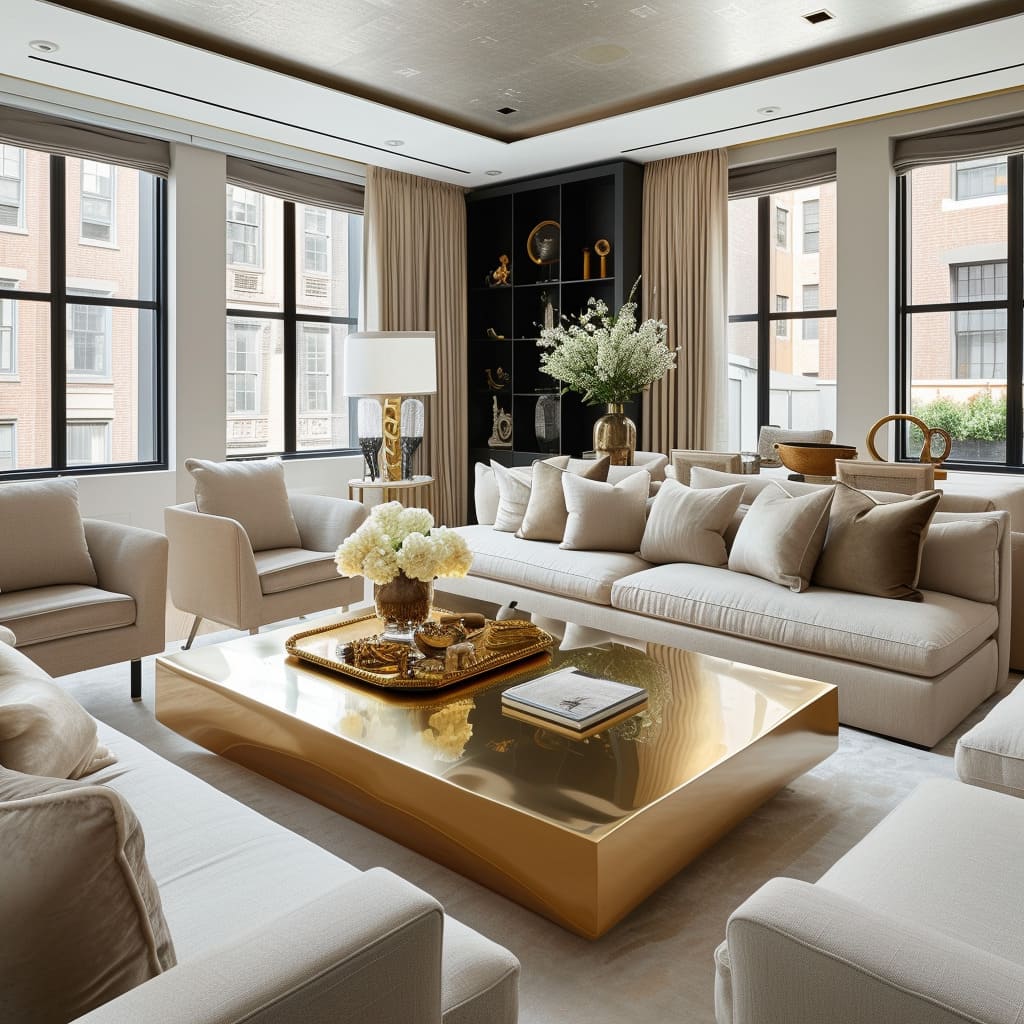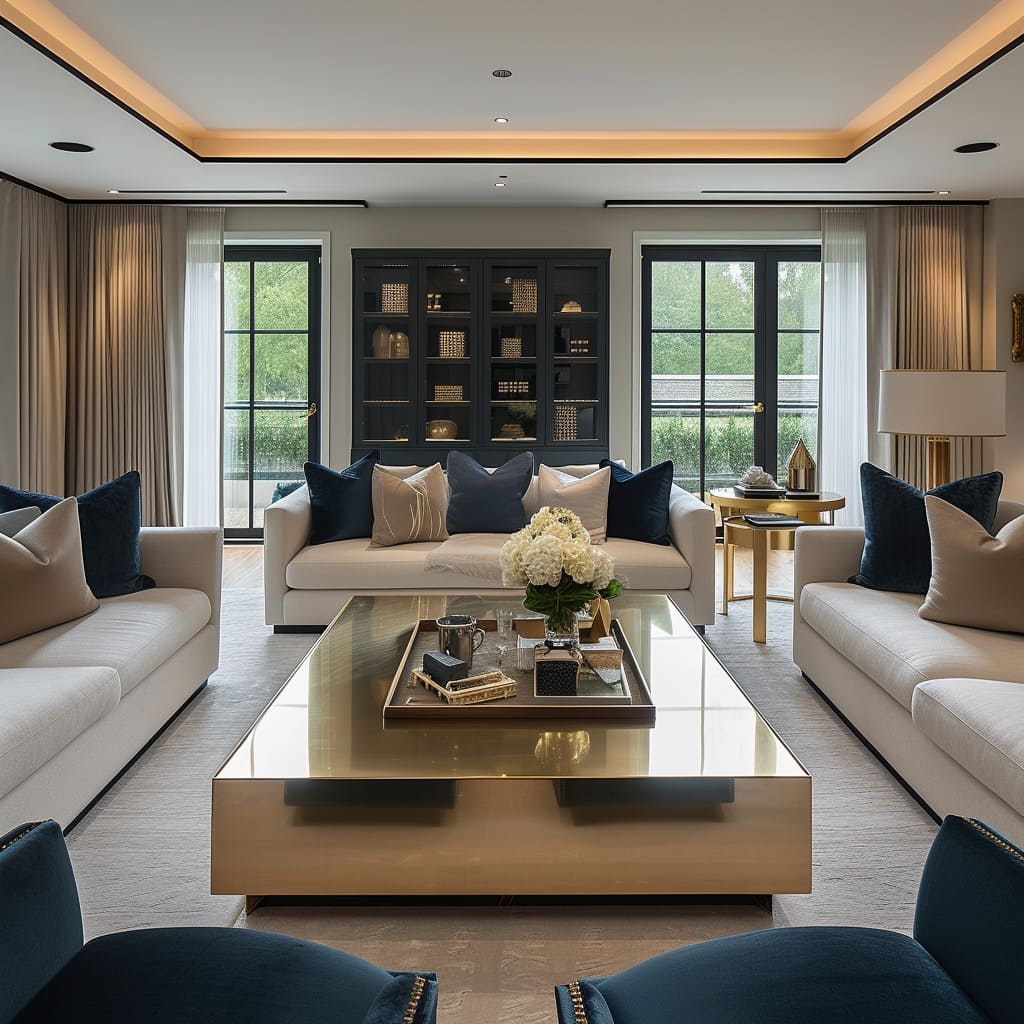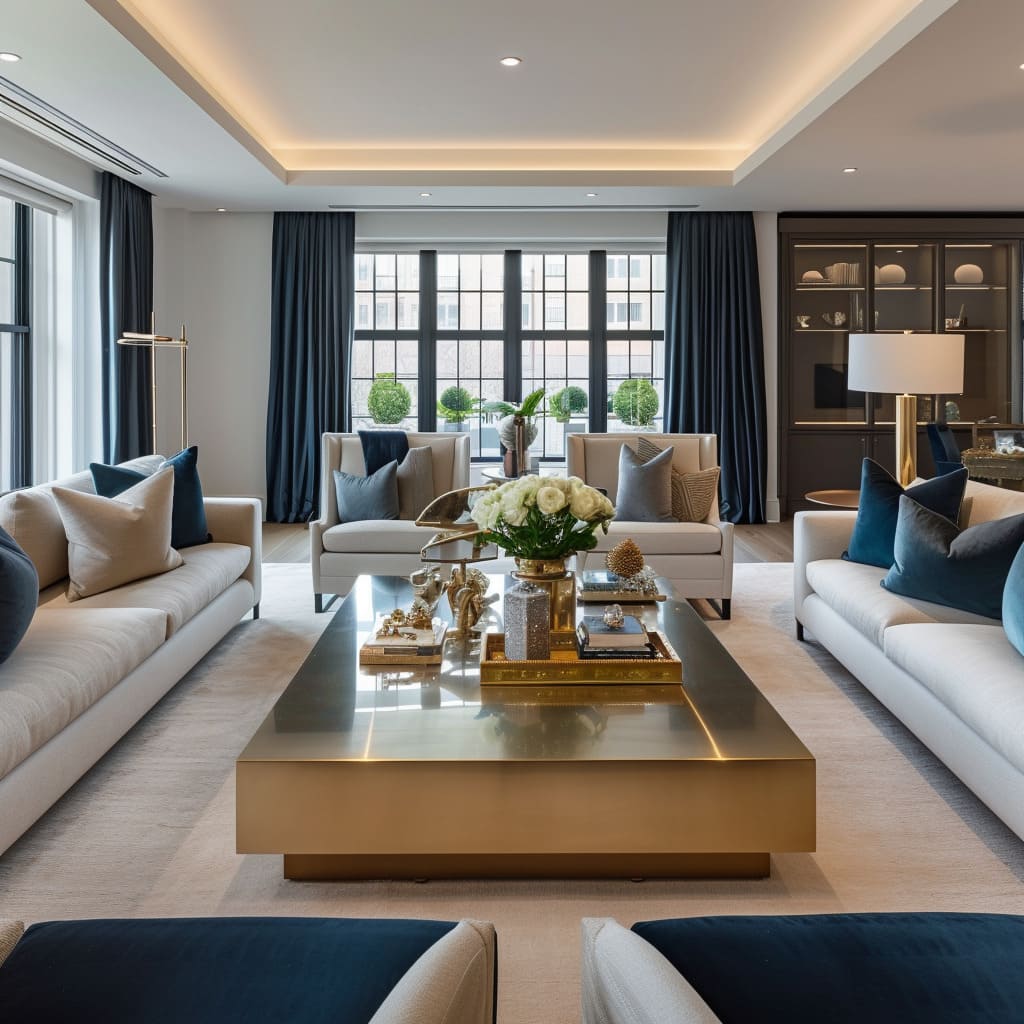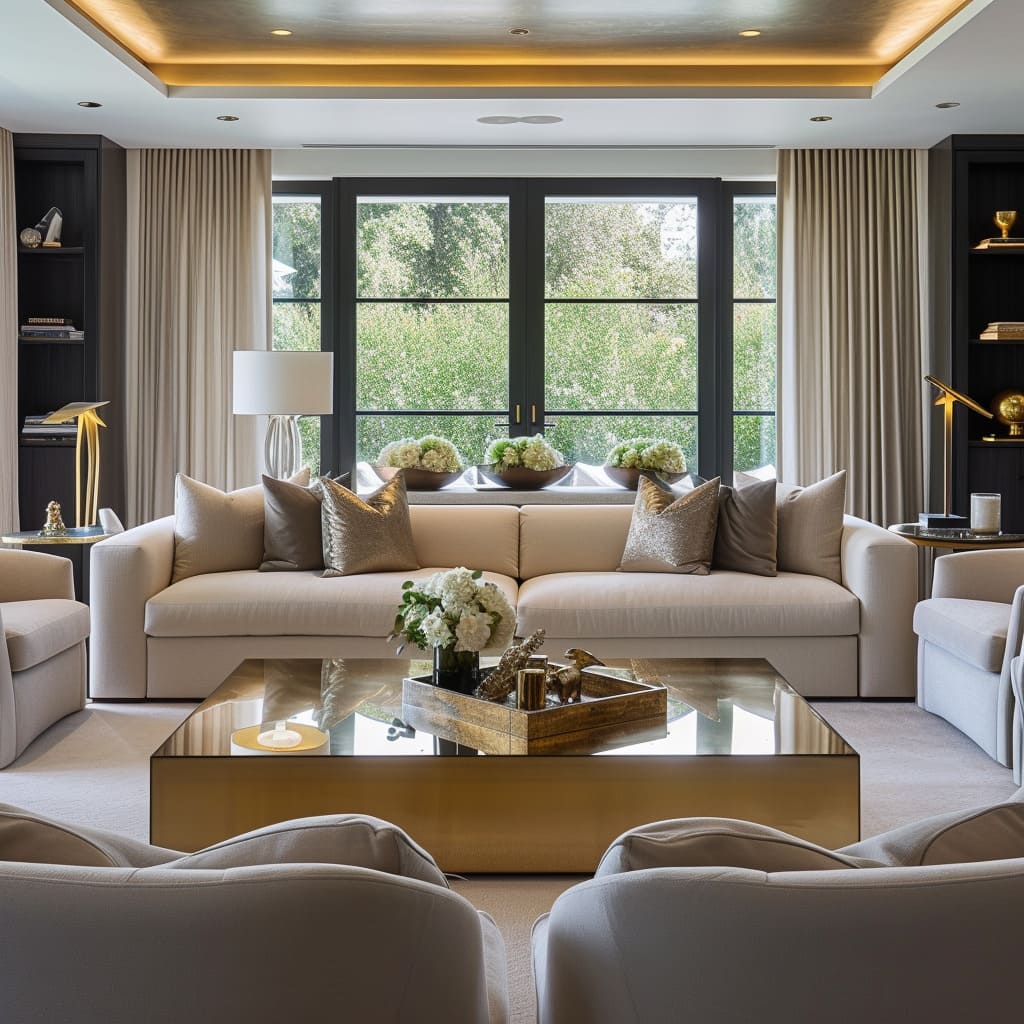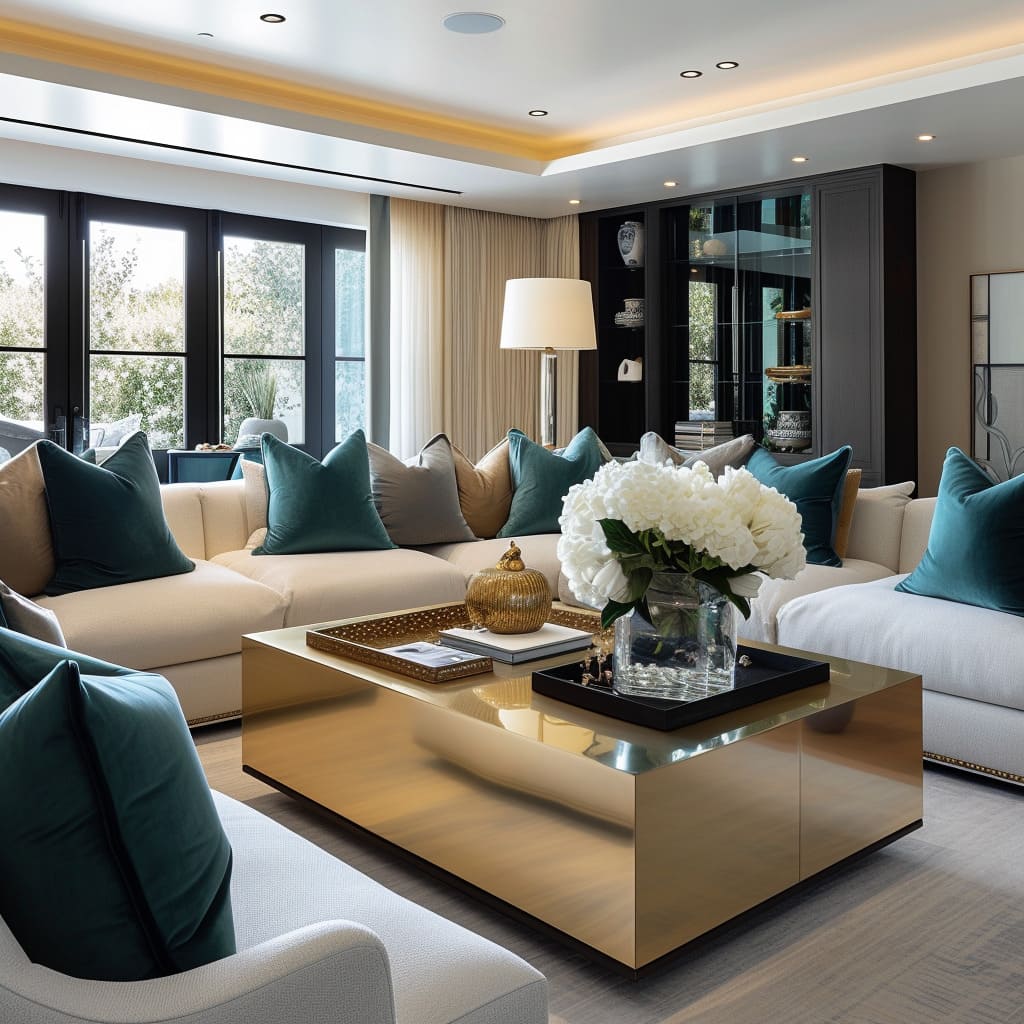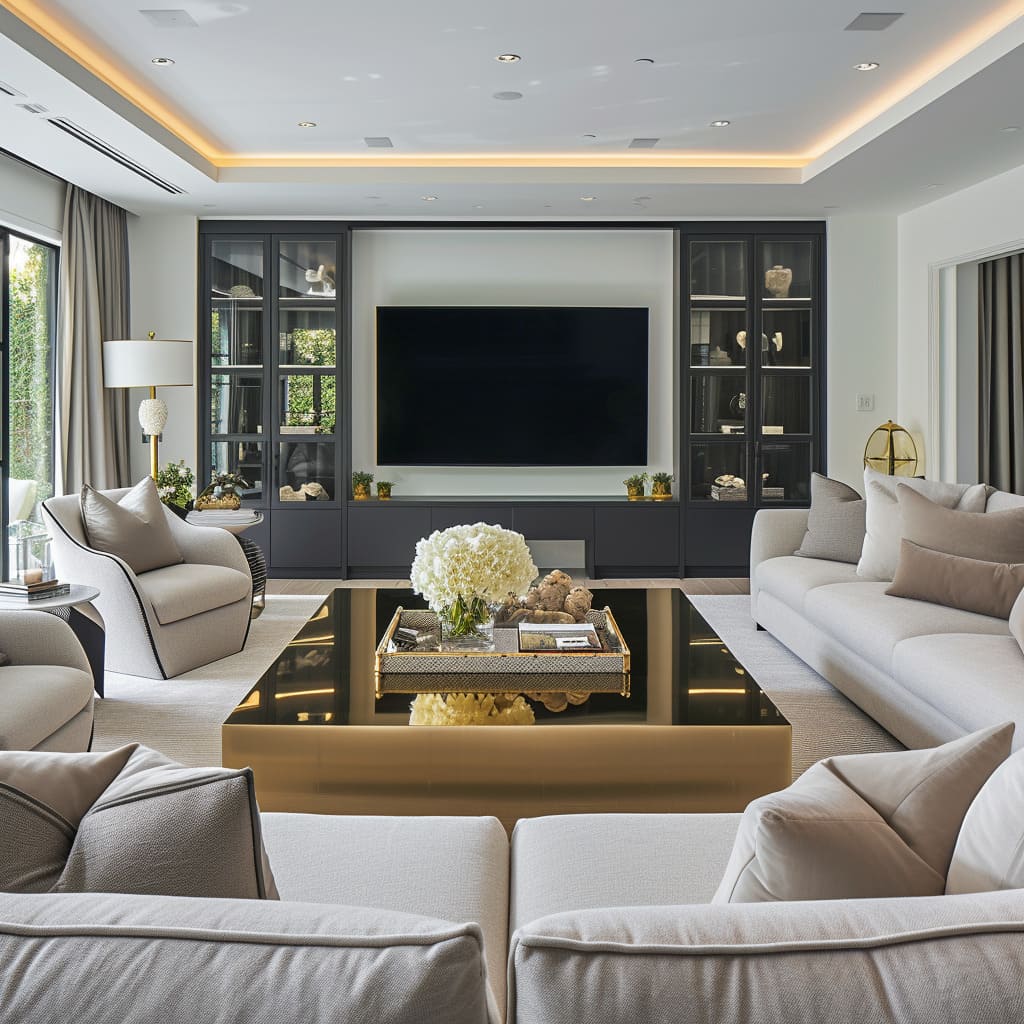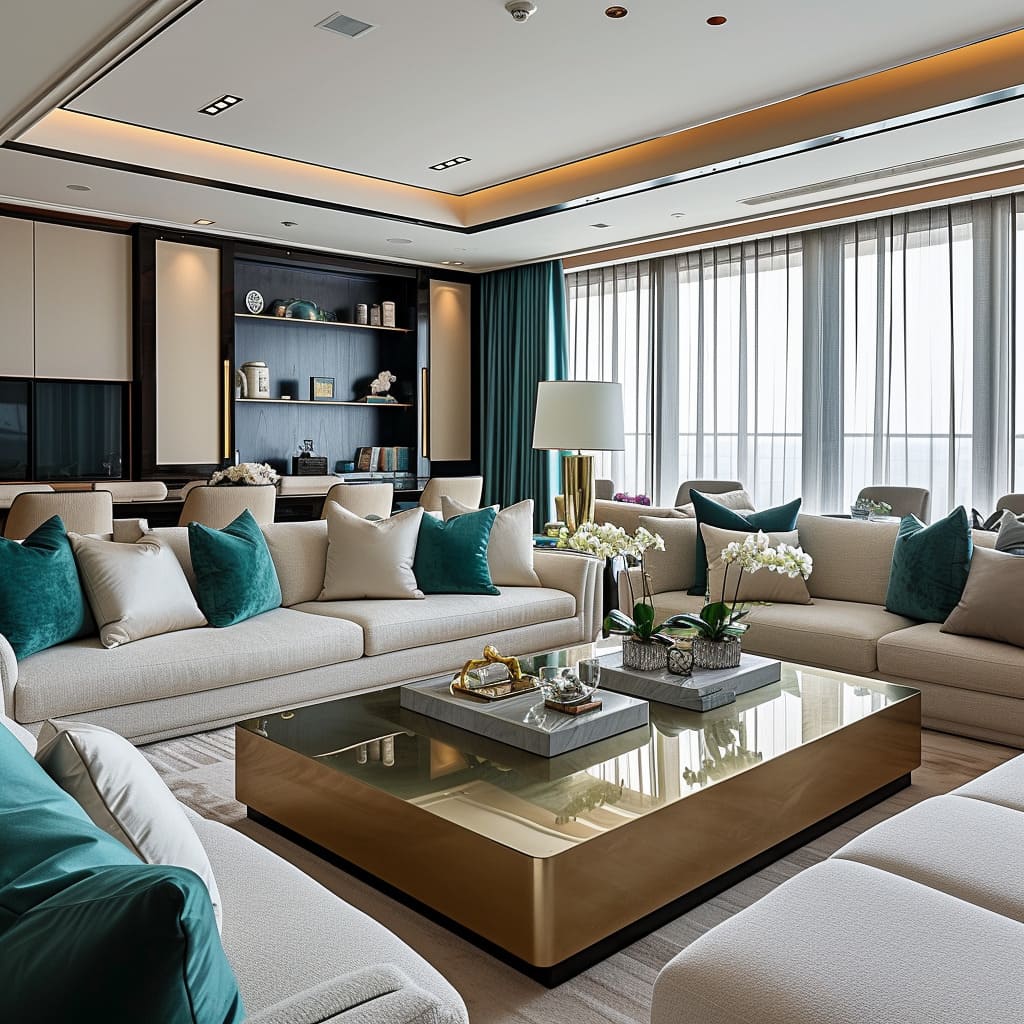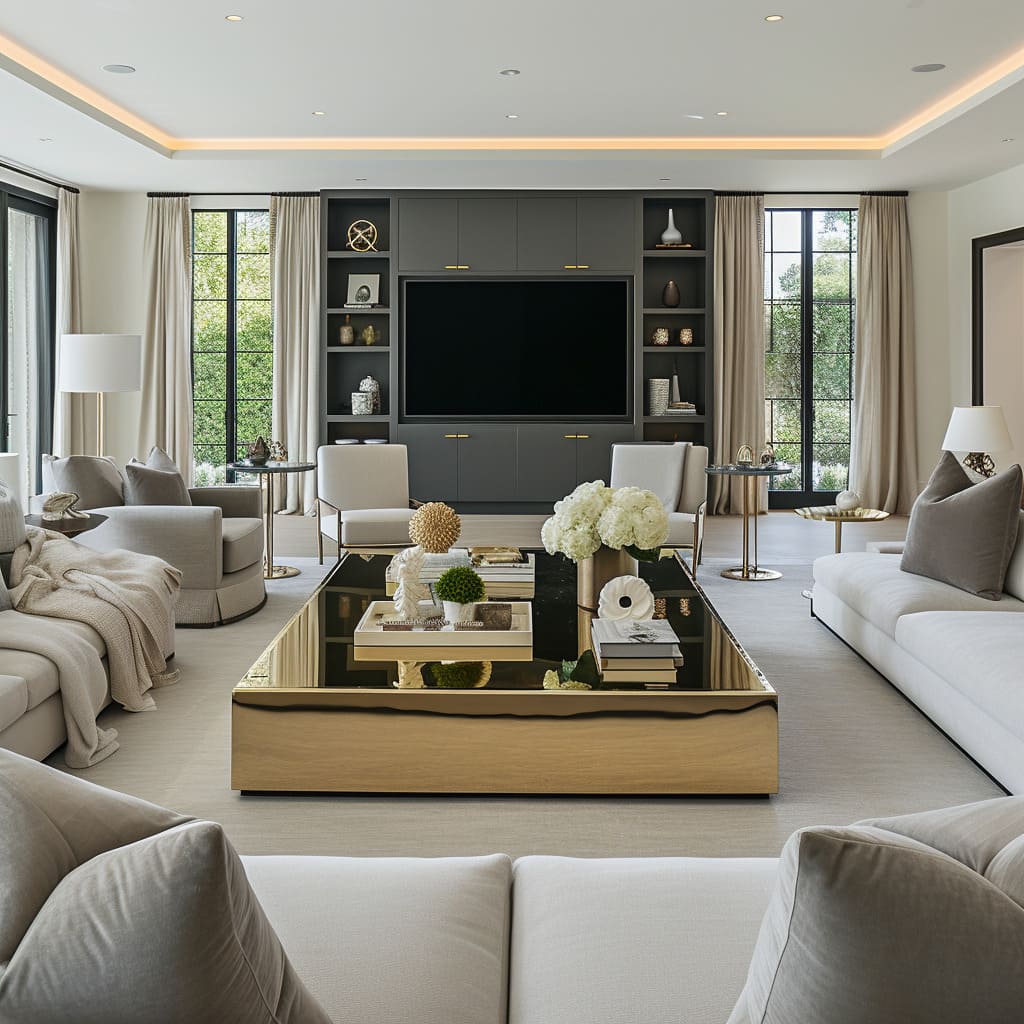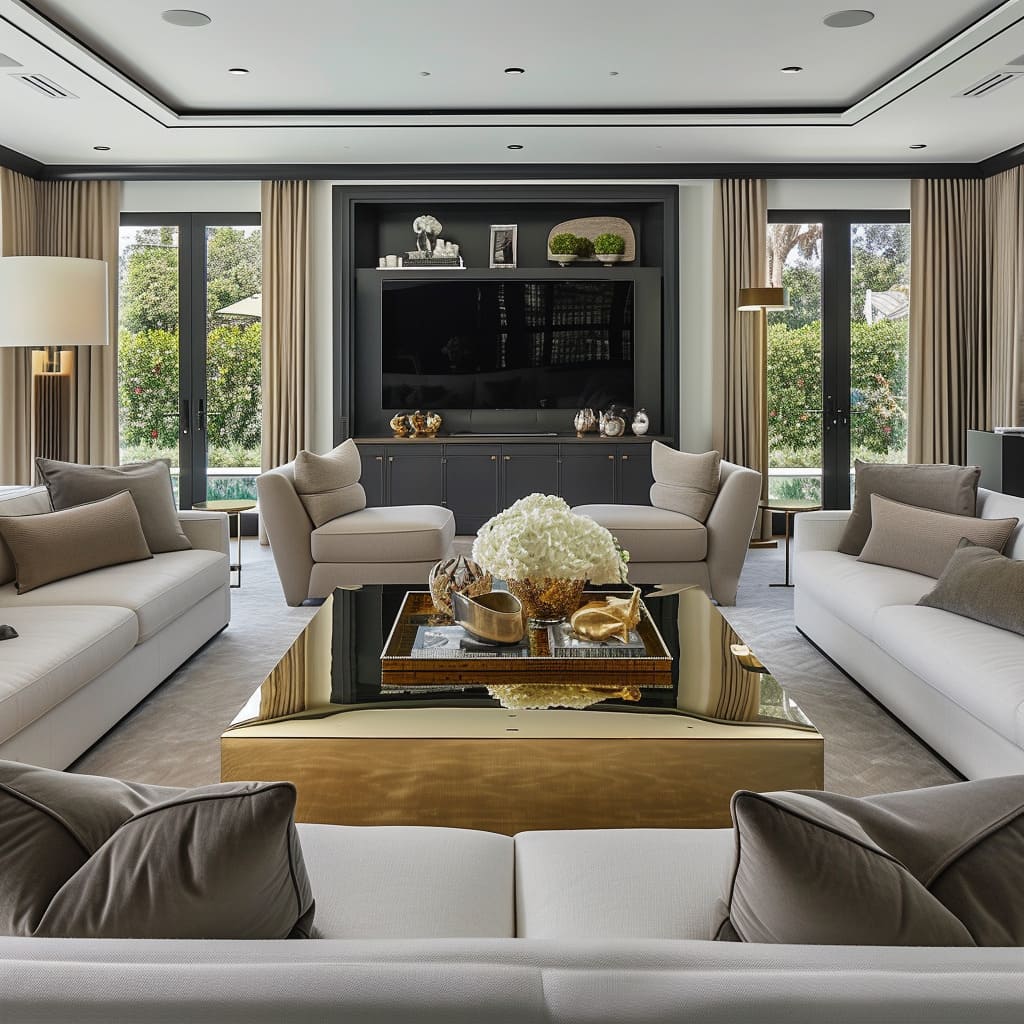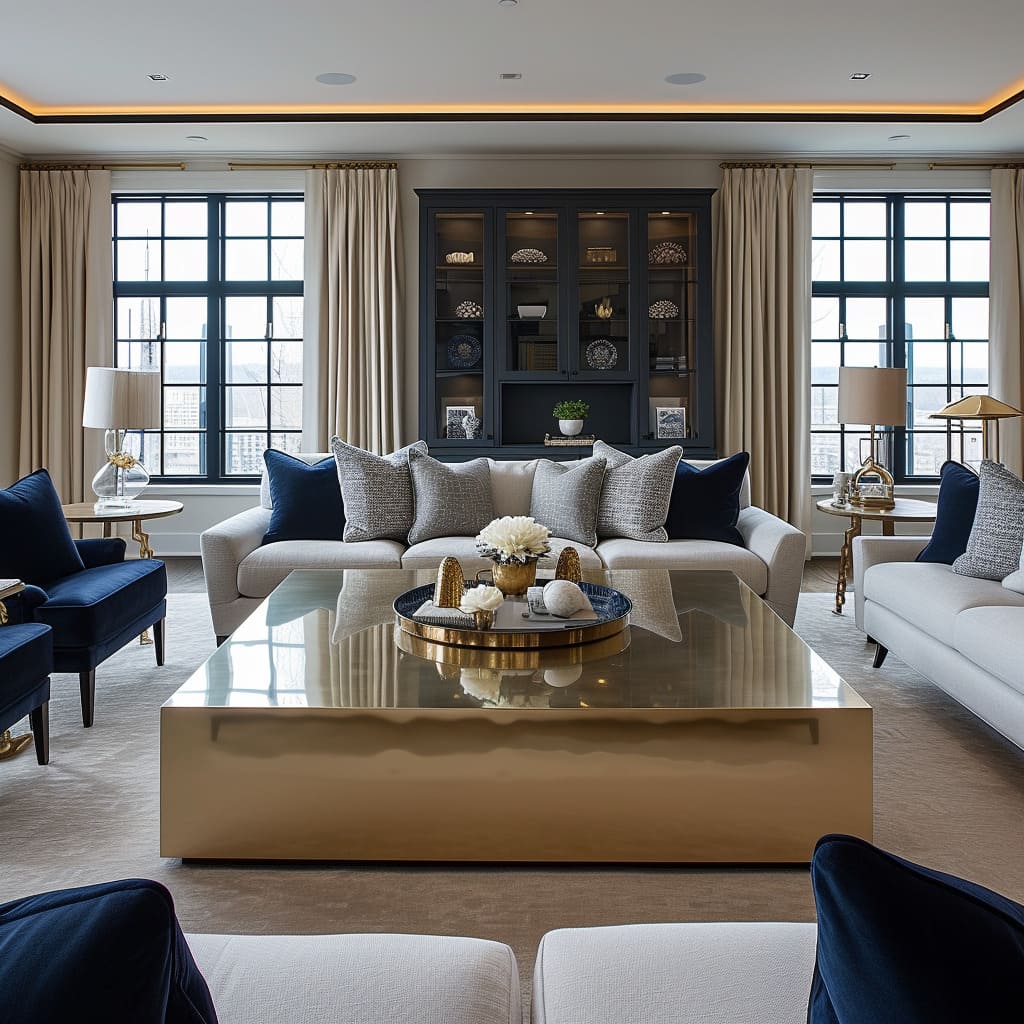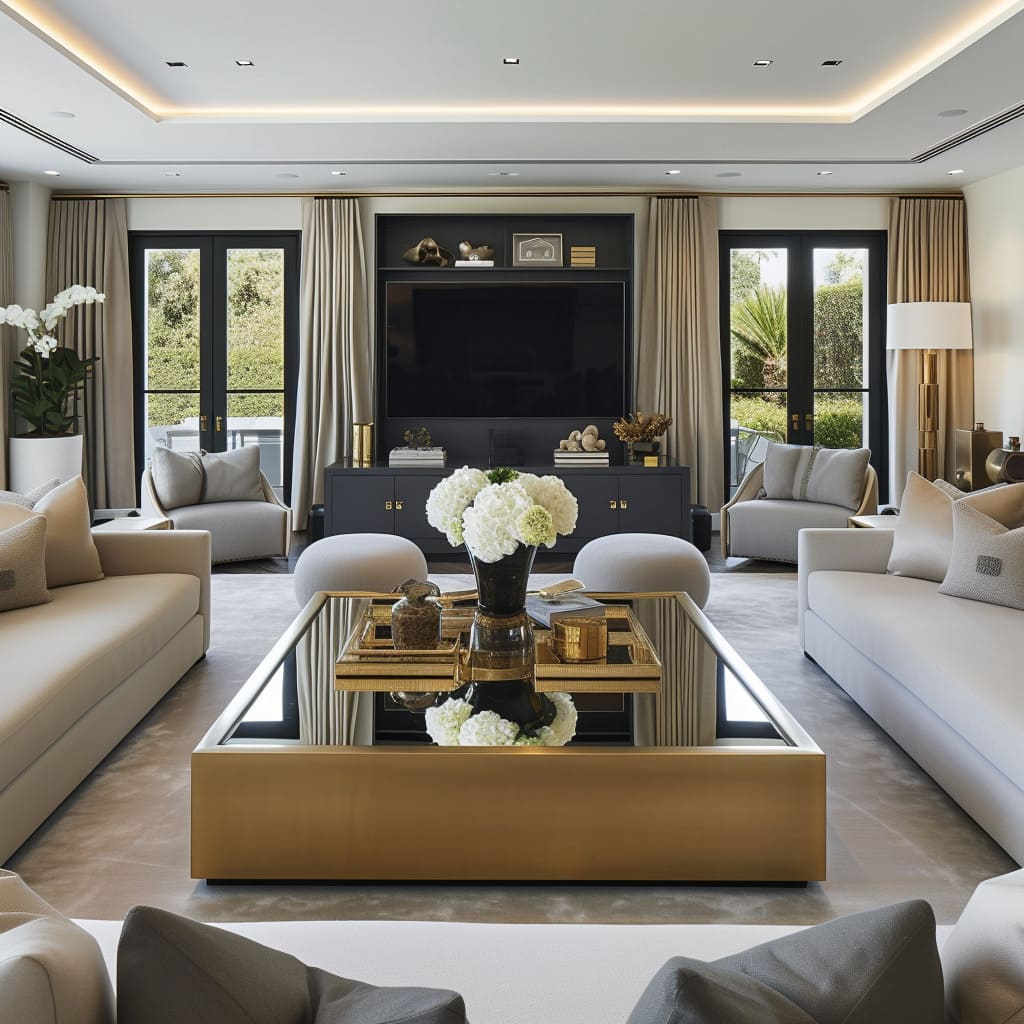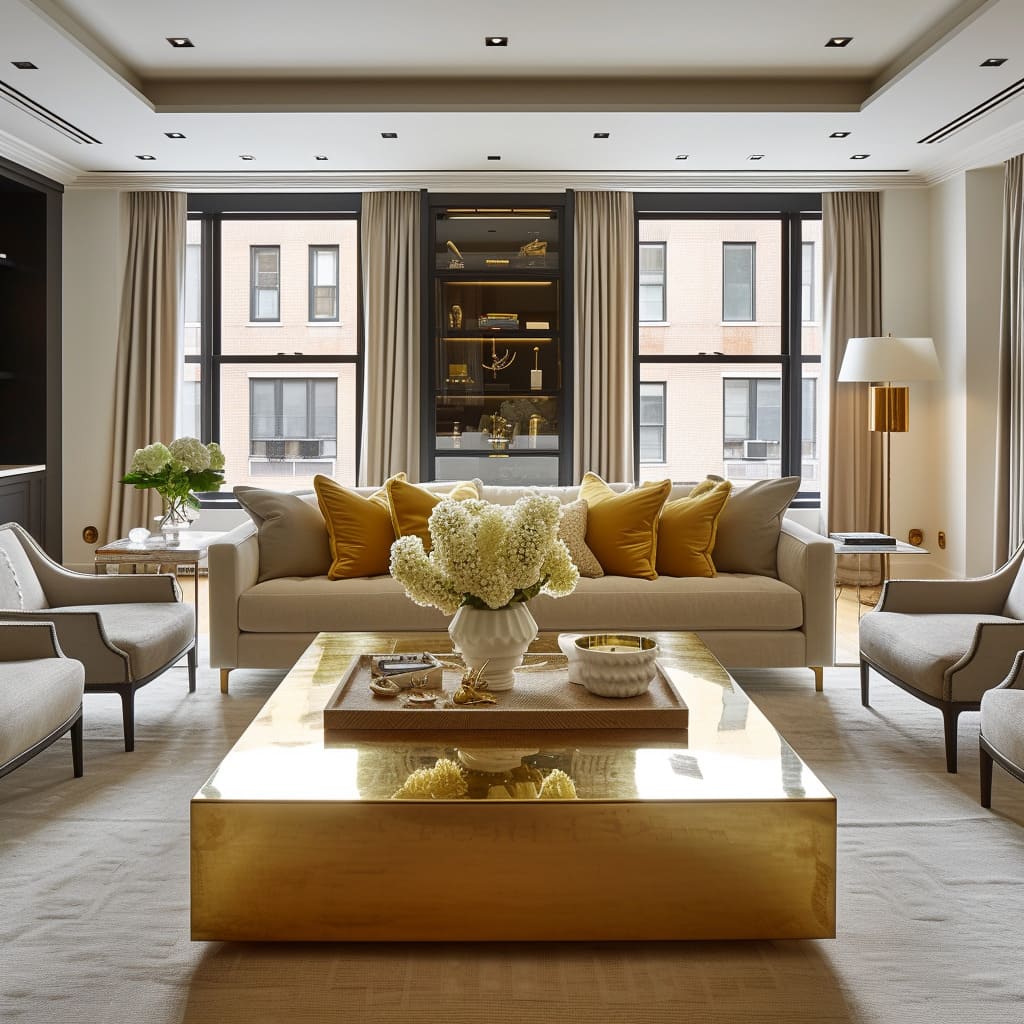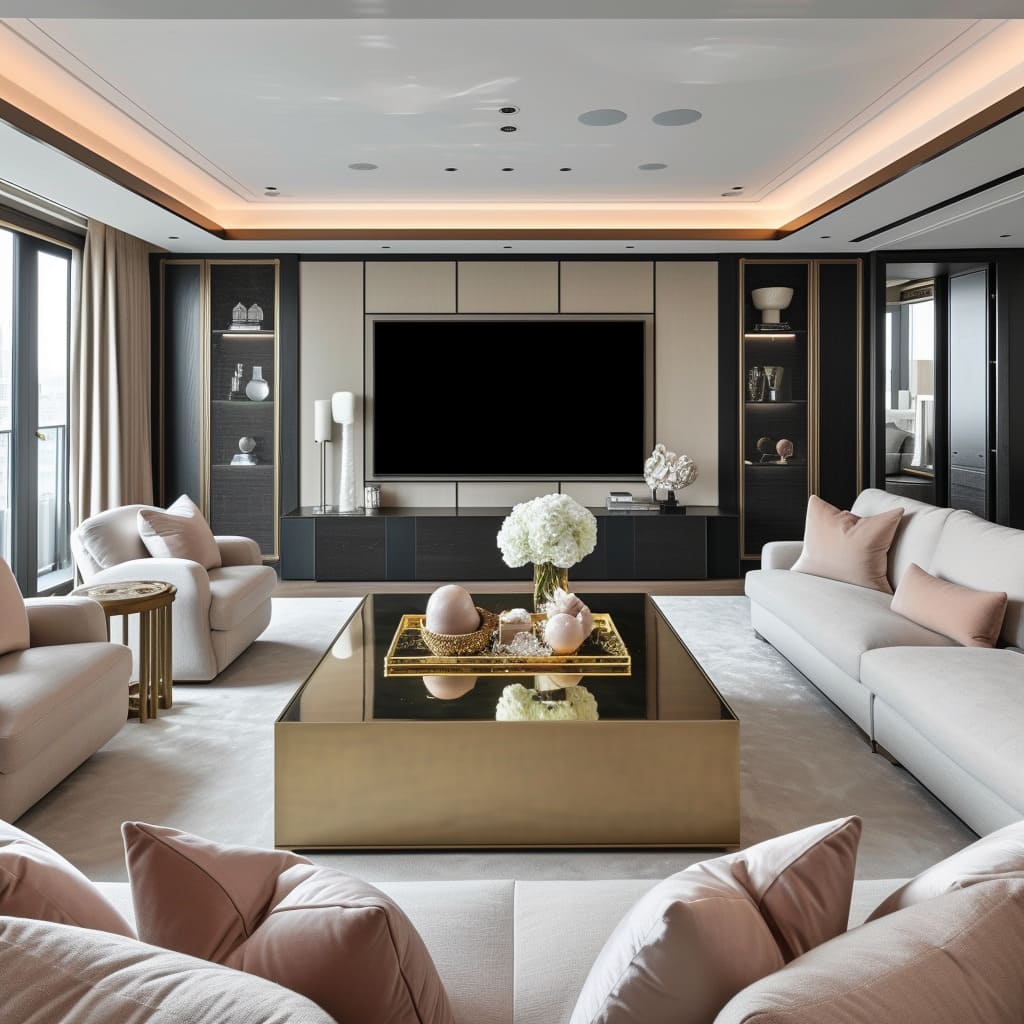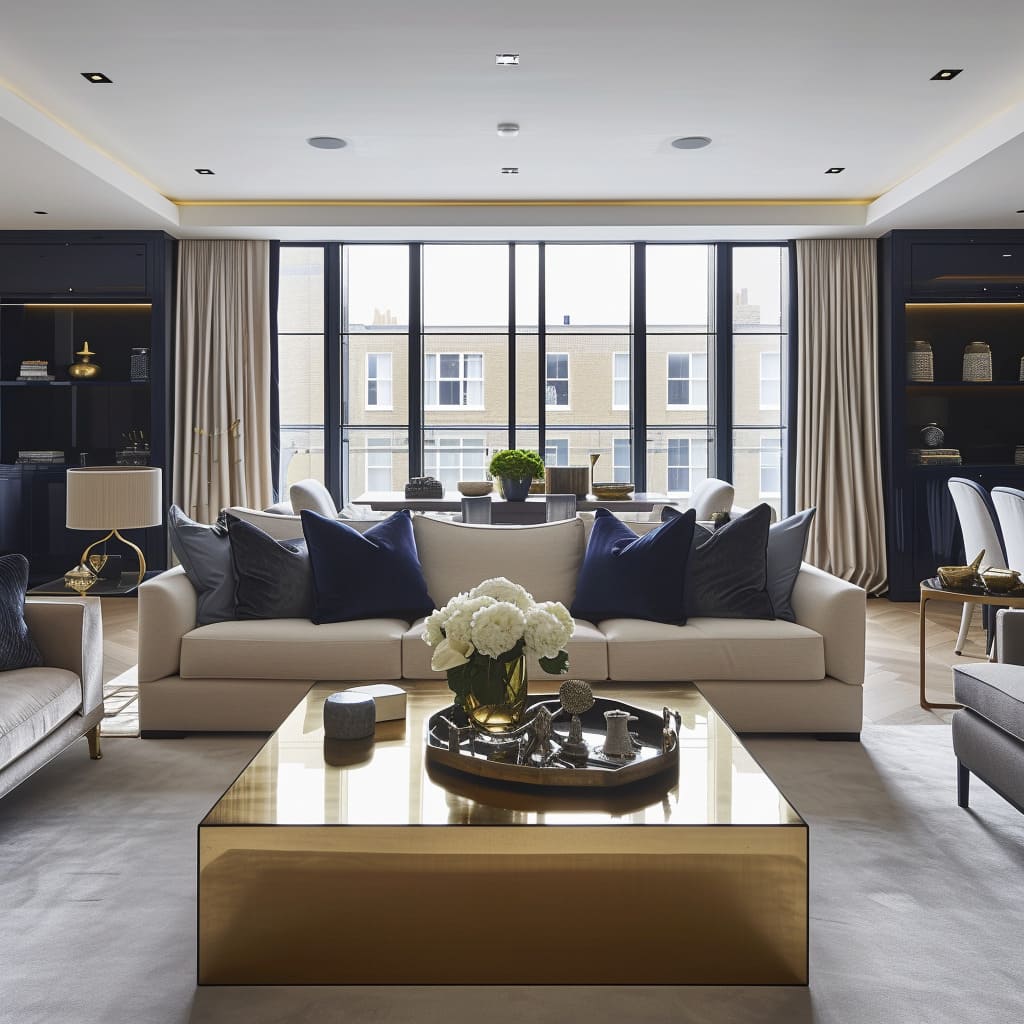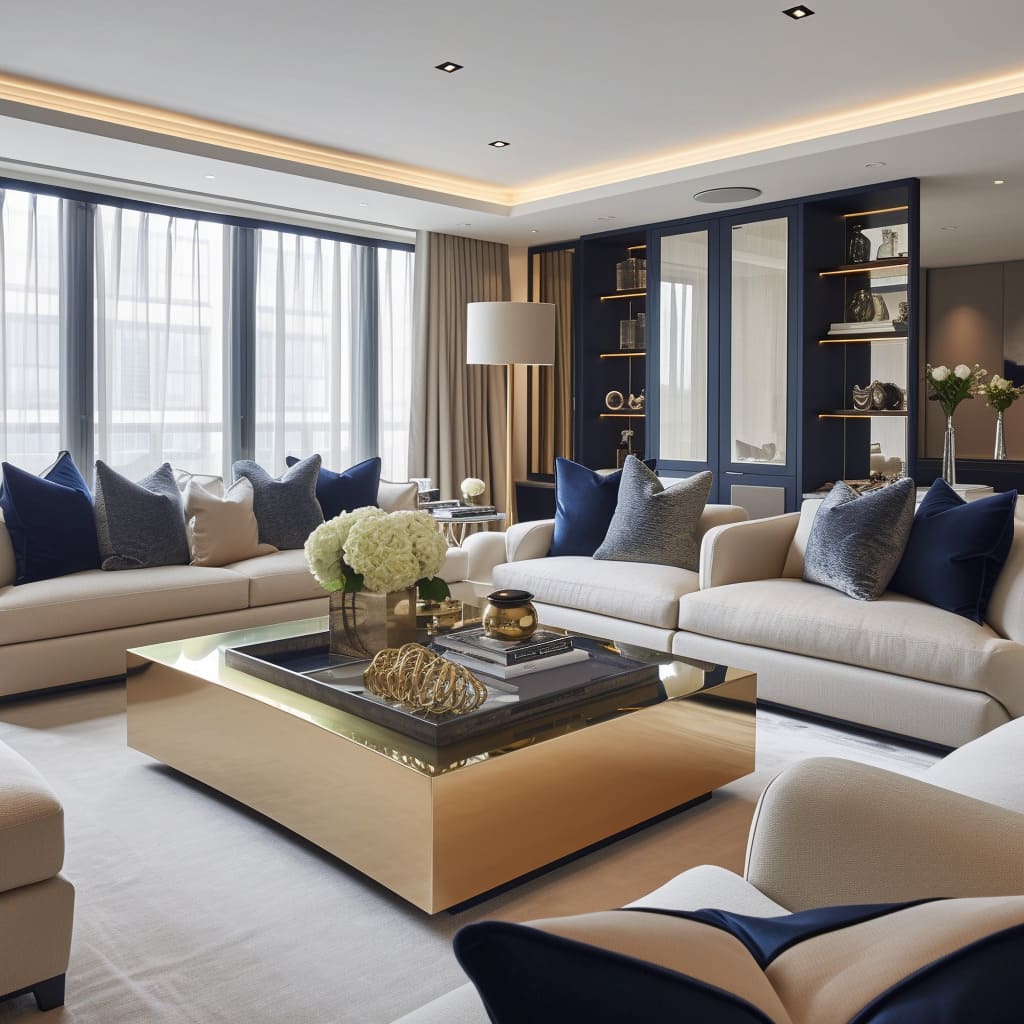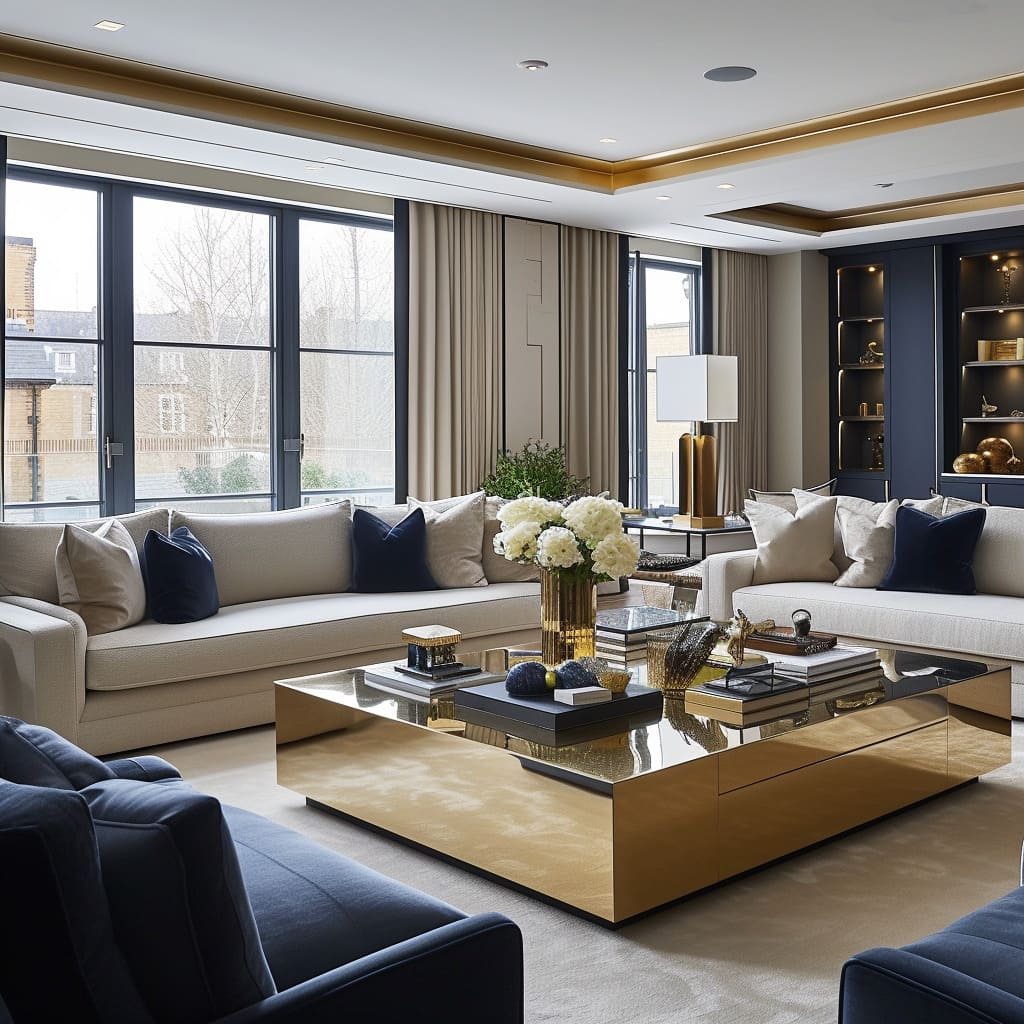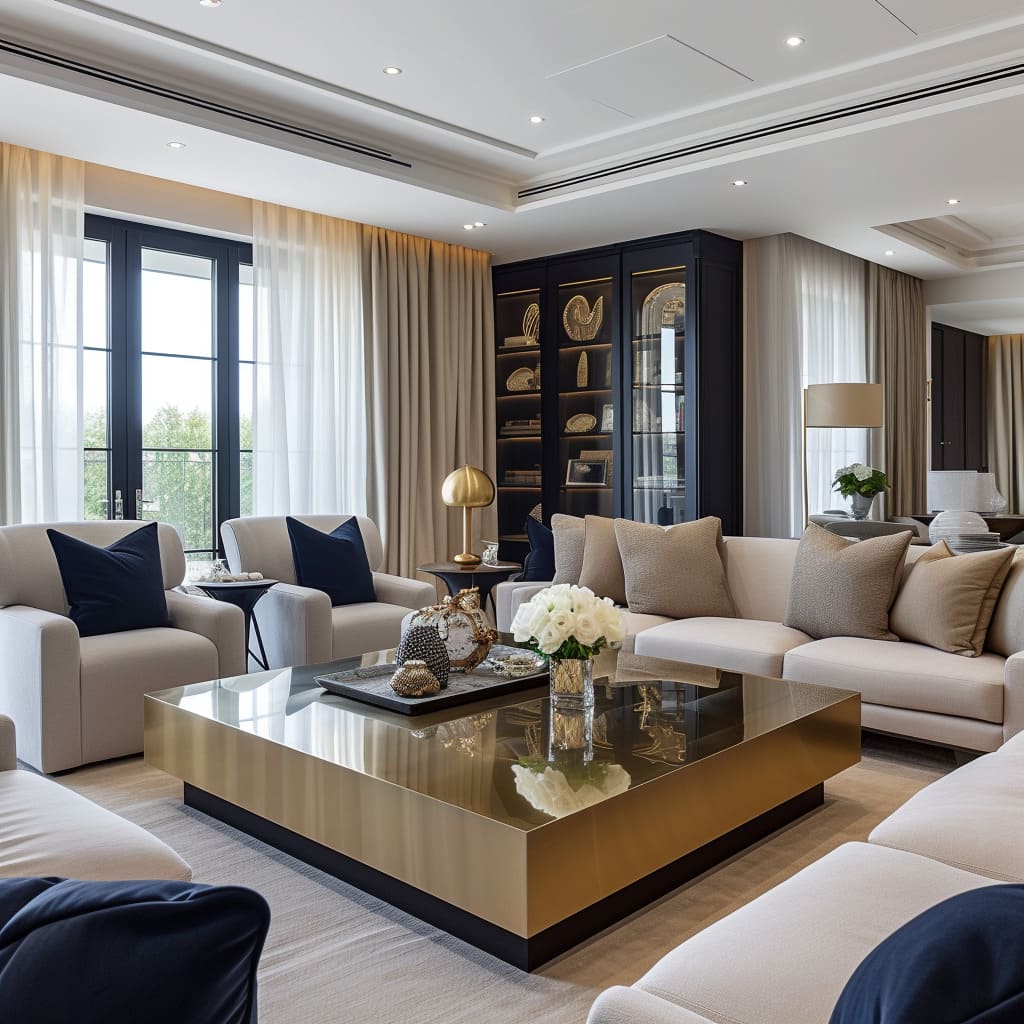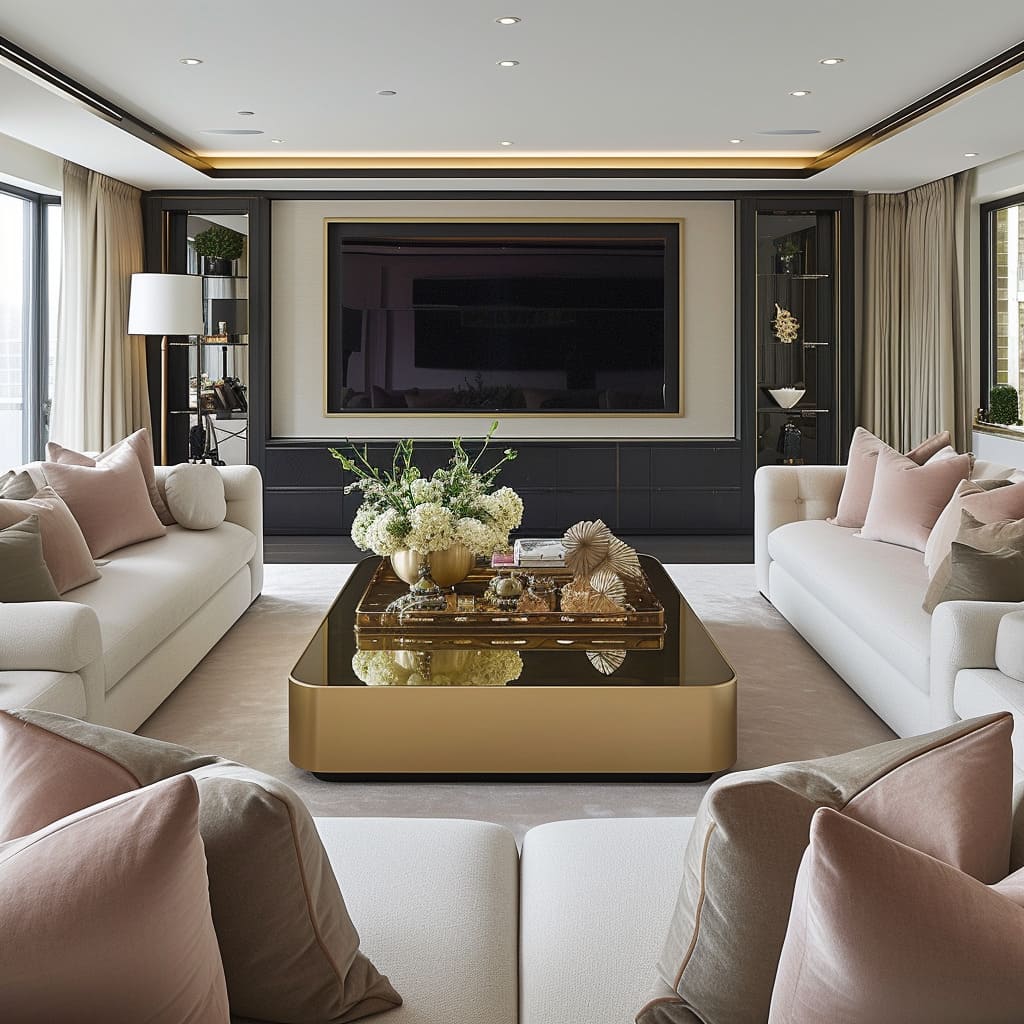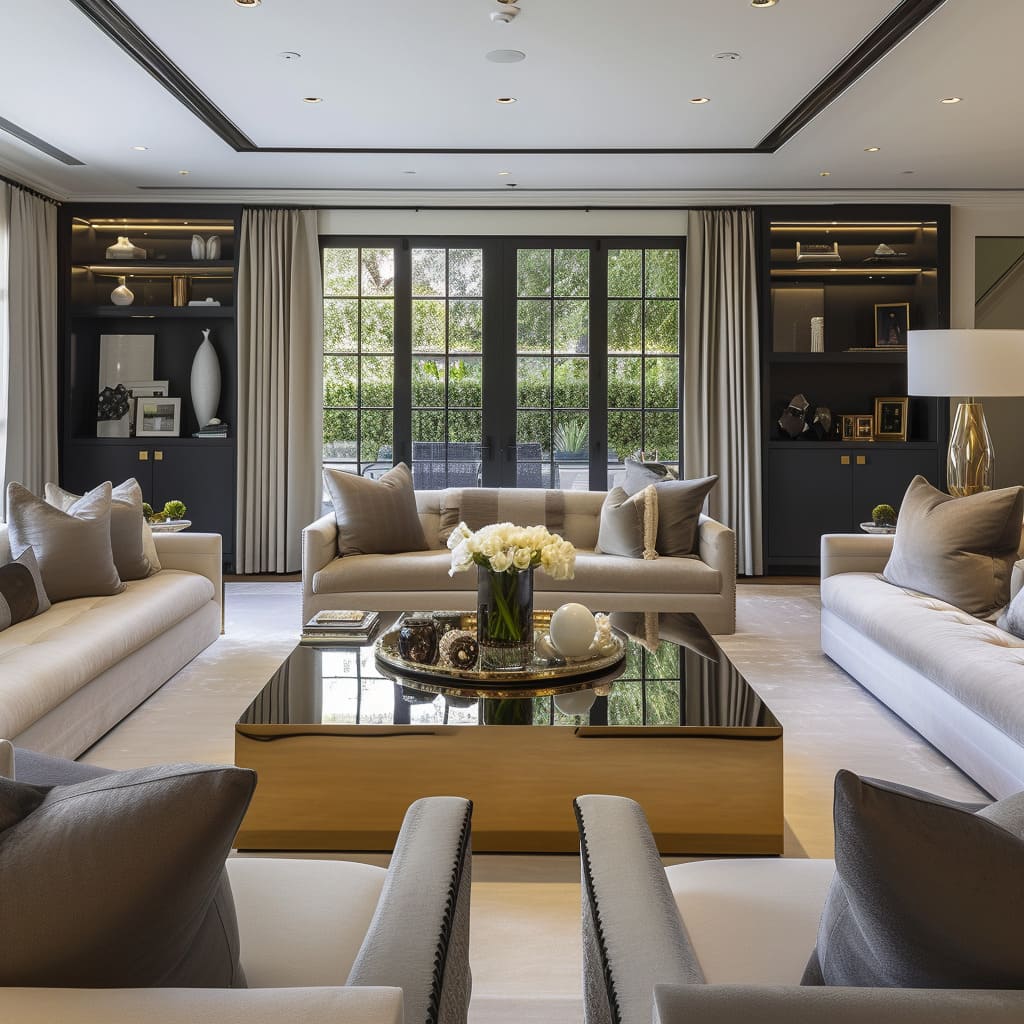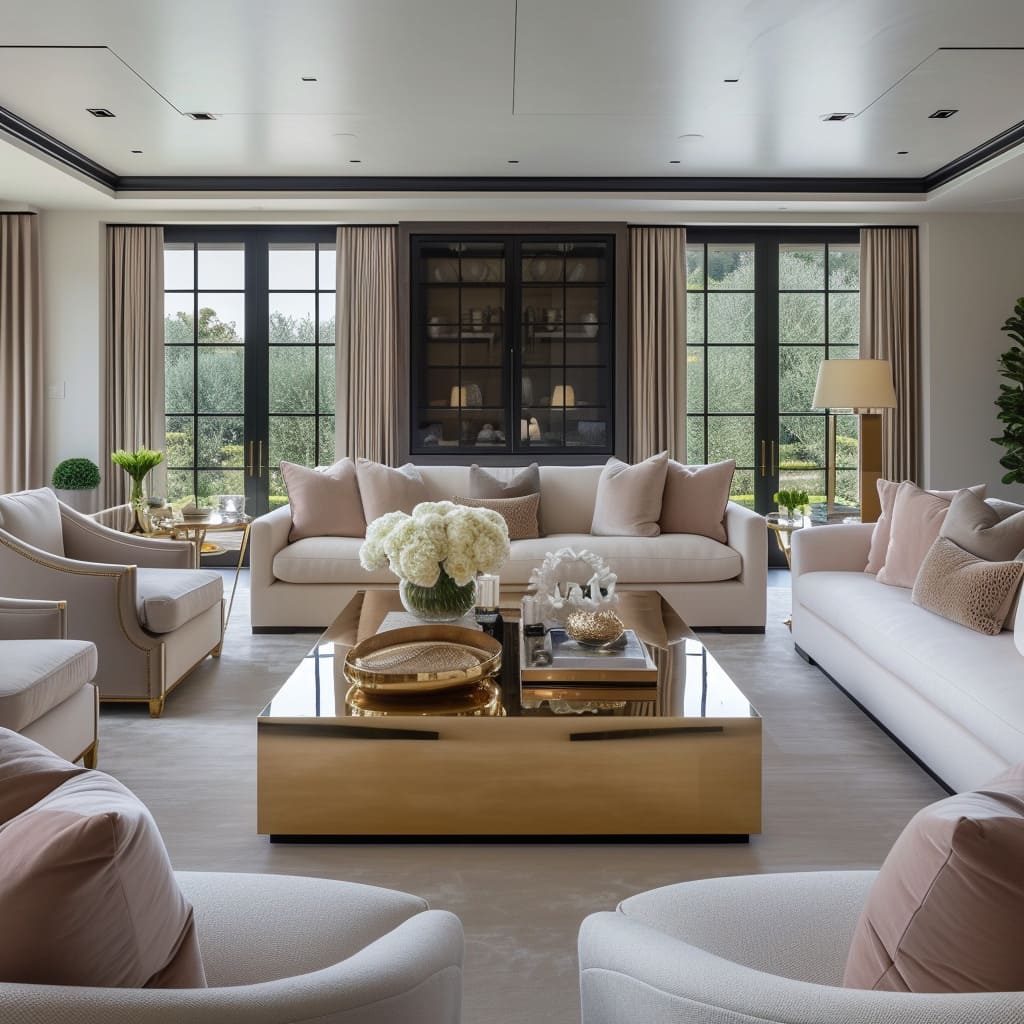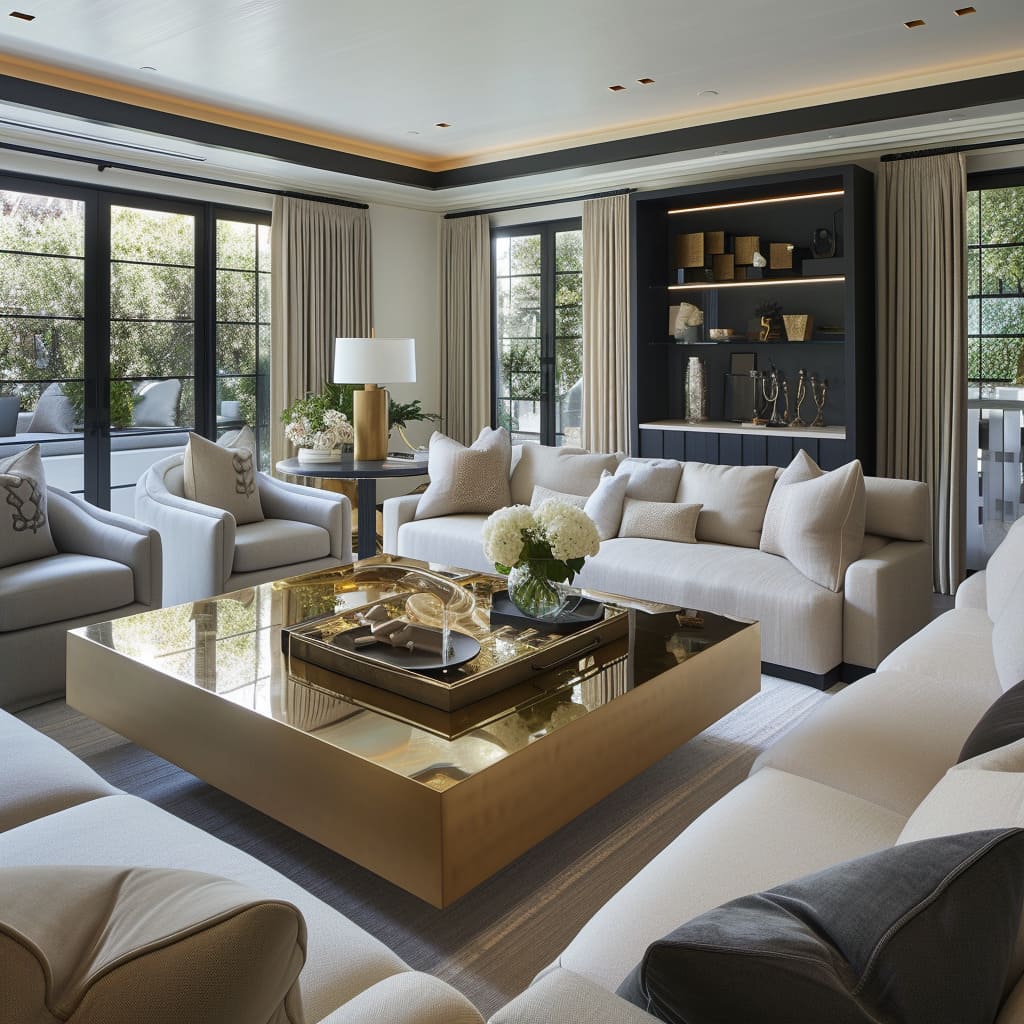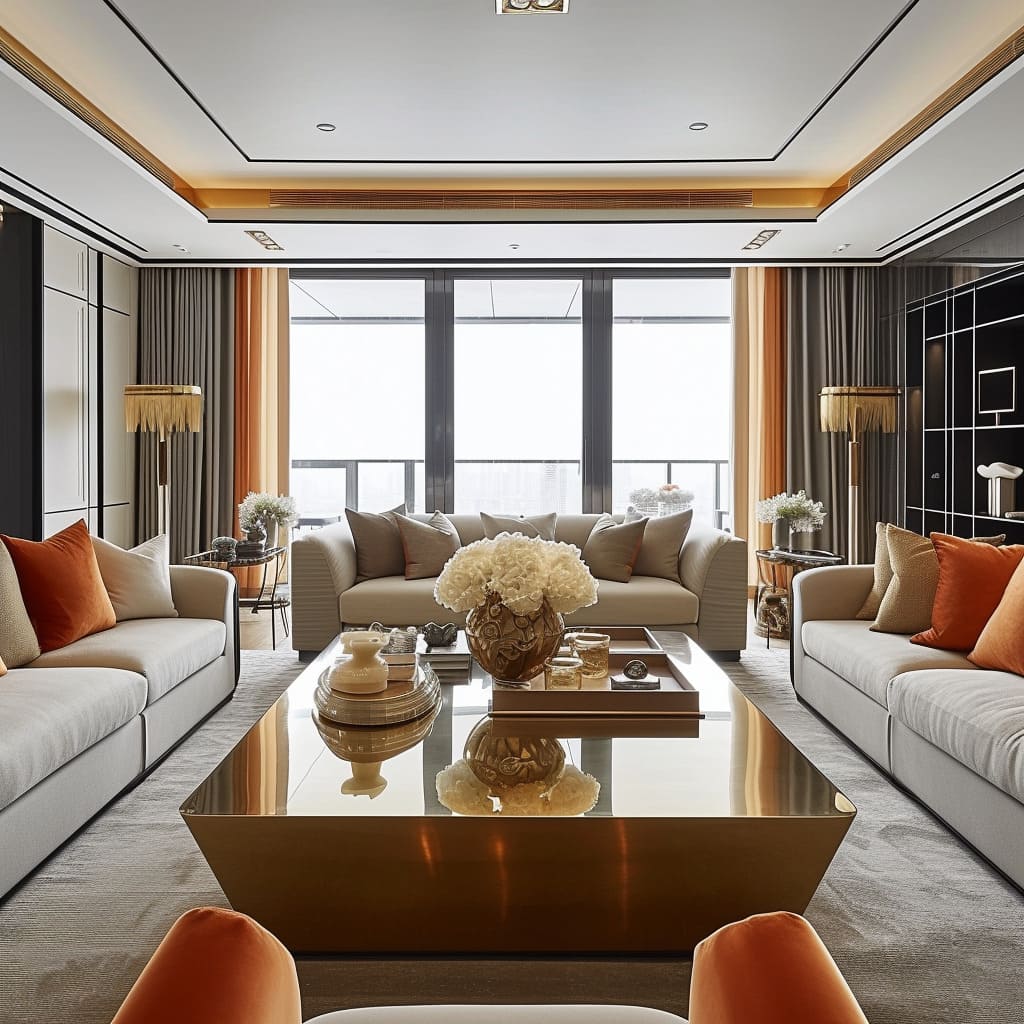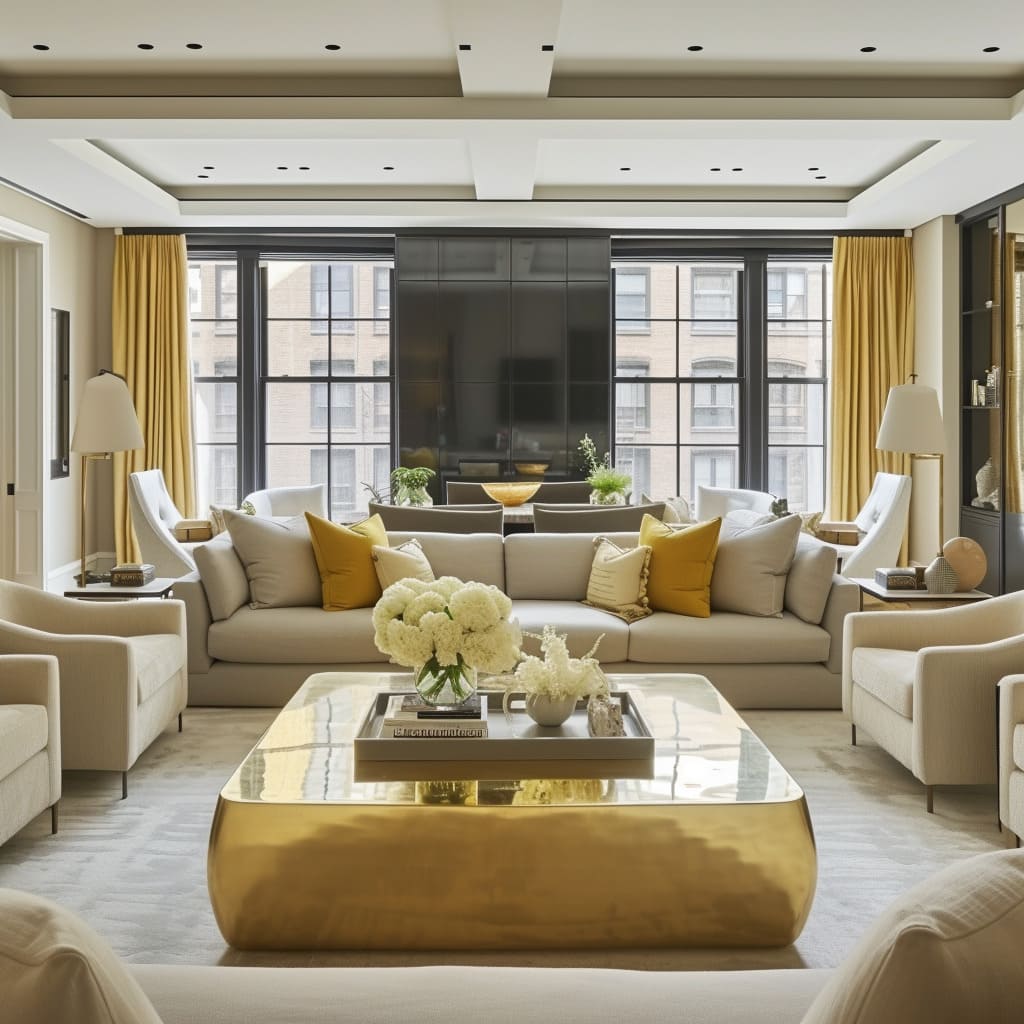As we cross the threshold into the sanctuary of sophisticated living, we encounter interiors that are not merely spaces but reflections of a design philosophy that marries luxury with livability. The living rooms presented in this visual journey are the epitome of modern elegance, where every texture and tone, every piece of furniture and fitting, speaks to a curated experience of comfort and style.
In these spaces, neutral palettes become canvases for splashes of rich color, while metallic finishes catch the light, creating an ambiance of warmth and refined taste. Plush seating invites relaxation, lighting sets the mood, and the flow of the space opens up to the outdoors, offering a seamless harmony with nature.
Through these meticulously designed environments, we discover the quintessential elements that define a luxurious modern home, promising a retreat that is both tranquil and invigorating, and always, undeniably chic.
Essence of Elegance: The Hallmarks of Bold Sophisticated Interior Design
A distinctive style that harmonizes comfort with luxury is often sought after but seldom perfected. The living spaces depicted here, however, capture this elusive blend with remarkable finesse.
Showcasing a modern and luxurious aesthetic, these rooms are a testament to design sophistication, where every detail works in concert to create an atmosphere that is both refined and welcoming.
From the subtle interplay of neutral tones and vibrant accents to the gleaming touch of metallic finishes, these interiors speak the language of understated opulence. Each element, whether it be the plushness of the seating or the strategic use of lighting, has been carefully selected to craft environments that are as visually stunning as they are comfortable.
This curated collection of features is not merely about following trends; it’s about setting a standard for elegance that transcends the ordinary, creating spaces that are timeless in their appeal and inviting in their warmth.
Use of Metallics
There is a consistent use of metallic finishes, particularly gold. Coffee tables and other decorative elements in gold add a touch of luxury and warmth to the rooms, reflecting light and contributing to a sophisticated atmosphere.
The golden elements are often found in the central furniture pieces, like the coffee tables that act as focal points in these spaces. Their shiny surfaces are not only aesthetically pleasing but also functional, as they are easy to clean and maintain.
Additionally, the gold is complemented by other metallics, such as brass or bronze, found in the detailing of furniture legs, lamp bases, and handles, further enriching the visual texture of the room. To incorporate such metallic finishes into your own interior, start with a statement piece like a gold-framed mirror or a brass lighting fixture.
It’s important to balance these shiny elements with matte or textured surfaces to avoid overwhelming the space.
Neutral Color Palette with Accent Hues
The rooms primarily use a neutral palette, consisting of whites, beiges, and grays, which serve as a backdrop for rich accent colors such as gold, navy blue, or mustard yellow. This creates an elegant and timeless feel, with pops of color adding depth and interest.
The choice of neutral base colors allows for a versatile backdrop that can be easily updated with different accent colors over time. In these rooms, the neutral walls and large pieces of furniture ground the space, while the accent colors draw the eye and provide character.
For example, mustard yellow throw pillows or navy blue armchairs become statement pieces that bring personality into the space.
To achieve a similar effect, one could start with a predominantly neutral interior and introduce color through accessories such as pillows, throws, or artwork, which can be changed seasonally or as trends evolve.
Plush Seating
The furniture, especially sofas and armchairs, is plush and inviting, with ample cushions for comfort. Upholstery is primarily in lighter shades, which contrasts with the darker accent pillows and contributes to the rooms’ inviting nature.
The seating is often designed with both aesthetics and ergonomics in mind, featuring deep seats and high armrests that support relaxation. Fabrics are selected for their texture and comfort, including soft wools, cottons, and velvets, which invite touch and use.
The use of various pillow sizes on the sofas adds an additional layer of coziness, allowing for customization of seating comfort. When choosing plush seating for your home, consider the scale of the furniture in relation to the room size, opting for pieces that provide comfort without dominating the space.
Mix and match different upholstery fabrics to add visual interest and tactile diversity.
Statement Lighting and Recessed Ceiling Lights
Each room features an array of lighting options, from statement pieces like large floor lamps to practical recessed ceiling lights. These not only illuminate the space but also serve as decorative elements that complement the modern luxury theme.
The statement lighting often takes the form of oversized floor lamps or sculptural pendant lights that act as works of art in their own right, drawing the eye upward and anchoring the space. Alongside these, recessed ceiling lights provide a layer of ambient lighting that can be adjusted for different moods and occasions.
To incorporate such lighting in your own space, consider the room’s function and the atmosphere you wish to create.
Use a mix of light sources at different levels — floor, table, and ceiling — to add depth and warmth. Dimmer switches can be a valuable addition, allowing for flexibility in lighting intensity to match the time of day or desired ambiance.
Open and Airy Spaces
The layouts are open and spacious, promoting a sense of tranquility and openness. Large windows are often dressed with sheer curtains, allowing natural light to filter in and enhance the airiness of the space.
The use of light-colored walls and floors further amplifies this effect, making the rooms appear more expansive. Furniture is arranged to encourage flow and movement, with clear pathways and a lack of clutter.
To achieve an open and airy feel in your own home, keep the color palette light and cohesive, reduce visual clutter by choosing furniture with clean lines, and maximize any natural light by using sheer window treatments or keeping windows unobstructed.
Reflective Surfaces
Mirrors, glass, and high-gloss finishes are strategically placed to reflect light and create a sense of expanded space. This includes mirrored coffee tables and shiny décor elements, which also contribute to the luxe feel of the designs.
Reflective surfaces double the impact of natural and artificial light, brightening the space and giving an illusion of greater volume.
They also add an element of glamour and sophistication. To integrate reflective surfaces into your home, consider placing a large mirror opposite a window to bring in more light or using mirrored furniture pieces as accents.
Glass tabletops and metallic finishes on hardware can also add subtle reflections and a touch of modern elegance without overwhelming the space.
Artistic and Decorative Elements
Each room contains carefully curated decorative items, such as sculptures, vases, and books, which are both aesthetically pleasing and personal. These items are often arranged in clean lines on coffee tables and shelves, maintaining a clutter-free environment.
The selection of these objects is not random; each piece is chosen to complement the room’s color scheme and contribute to the overall narrative of the design. Art pieces are strategically placed to draw attention and provoke thought, while decorative vases and bowls add form and function.
To incorporate artistic and decorative elements into your interior, focus on selecting items that resonate with your personal style and interests. Consider the scale and color of each piece and how it will fit within the existing room.
Group smaller items together to create visual impact, and leave some negative space on shelves and tables to let each piece stand out.
Texture Variety
There’s a deliberate mix of textures, from the softness of the sofas and rugs to the smoothness of the metal and glass. This variety adds depth and complexity to the interiors, preventing the neutral color scheme from feeling flat or monotonous.
Textural contrasts can be seen in the pairing of plush upholstered furniture with sleek, reflective coffee tables or the layering of thick, knitted throws over smooth leather chairs. This interplay of textures is vital for engaging the senses and creating an inviting space.
When trying to enhance texture variety in your own home, consider incorporating a range of materials across your furnishings and accessories. Think about the tactile quality of every element, from the rug underfoot to the throw pillows on your couch.
Varying textures through accents such as curtains, wall hangings, or even plants can also contribute to a richly layered interior.
Symmetry and Balance
The arrangement of furniture and décor often displays symmetry, which contributes to a balanced and harmonious look. This is seen in the placement of sofas, armchairs, and decorative items, creating a well-organized and thoughtfully designed space.
In these interiors, symmetry is not just about duplicating items on either side of a central point; it’s about creating visual pairs that make the space feel orderly and anchored.
For example, matching lamps on identical side tables or a pair of artworks hung side by side can reinforce symmetry. To achieve symmetry and balance in your own space, start by identifying the focal point of the room, such as a fireplace or a large window, and arrange furniture in a mirrored layout around it.
Use pairs of lamps, cushions, or chairs to create symmetry. However, it’s important to balance this with some asymmetrical elements to prevent the space from feeling too rigid, adding life and interest to the design.
Custom Cabinetry and Shelving
Built-in cabinets and shelves are a common feature, providing storage that is both functional and stylish. These are often in dark tones, which contrast with the lighter walls and furnishings, adding a dramatic flair to the rooms.
The cabinetry is crafted to fit perfectly within the room’s architecture, maximizing space and contributing to a bespoke look. It’s not uncommon to see these storage solutions extend from floor to ceiling, which emphasizes the room’s height and offers extensive storage.
The shelves are also an opportunity to display curated items that add personality to the room.
For those looking to integrate custom cabinetry and shelving into their own space, it’s crucial to consider both the form and function. Work with a skilled carpenter to design units that fit your specific storage needs and room dimensions.
Choose a color for your cabinetry that complements your wall color but don’t be afraid to opt for a bold contrast to make a statement.
Integration with the Outdoors
Many designs feature large windows or glass doors that provide views of the outside, connecting the interior space with nature. This not only brings in natural light but also extends the living space, blurring the lines between indoors and outdoors.
The windows are often unadorned or dressed with minimalistic treatments that do not obstruct the view, reinforcing the connection to the outdoors. The use of natural materials within the room, such as wood or stone, can further this indoor-outdoor relationship.
To bring this element into your home, consider if there are any barriers that can be removed or minimized to enhance the outdoor view. Incorporate indoor plants and use materials that echo those found in the view outside to strengthen the connection to nature.
Floor Coverings
Rugs are used to define seating areas, add warmth, and enhance the room’s acoustics. Their textures and patterns vary, but they always complement the overall color scheme and design aesthetic.
In these living spaces, rugs often serve as the anchor for the furniture, delineating the main living area in an open-plan space. They are selected not just for their color or pattern but for their ability to withstand foot traffic while still feeling luxurious underfoot.
When selecting rugs for your home, consider the size of the rug in relation to the seating area it is defining. It should be large enough that the front legs of sofas and chairs can rest upon it, creating a unified look.
Additionally, choose a rug that matches the room’s usage; for example, a more durable, easy-to-clean rug for a family room, or a softer, more luxurious one for a less-trafficked formal living room.
In conclusion, the intricacies of these living spaces do more than just fill a room with furniture and decor; they weave a narrative of elegance and luxury that invites one to linger and enjoy. The use of a neutral color palette punctuated with deliberate hues, the strategic incorporation of metallics, and the thoughtful arrangement of plush seating all serve to create an inviting yet sophisticated atmosphere.
Statement lighting and airy layouts infuse each room with life, while reflective surfaces and a variety of textures add a dynamic visual interest.
Artistic elements offer personal touches that make a house feel like a home, and the symmetry and balance provide a serene order to the space. The custom cabinetry and shelving ensure that functionality walks hand in hand with style, whereas the integration with the outdoors and the selection of floor coverings harmoniously bridge the gap between comfort and chic.
Ultimately, these rooms exemplify how the principles of design can be applied to craft spaces that are not only aesthetically remarkable but also resonate with the essence of modern luxury living.


